UNDER CONSTRUCTION!!
CHAPTER V
WEN RITES
1. NYING, CHIIK, WEN, PAGREM
According to the Bulsa, in addition to the body (sing. nying; pl. nyingsa), every human being has spiritual components that are closely connected to their life, such as chiik (pl. chiisa), wen (pl. wena), and pagrem.
Chiik
While the wen is always outside the body and can have a strong, fateful influence on the body and way of life from there, the chiik (often translated as “soul”) is bound to the body more strongly. It is not located in a specific organ but in all parts of the body.
Where the chiik comes from does not seem to be clear to many Bulsa, although one often hears the answer “From God” (Naawen) or “From heaven” (wen). In any case, I did not receive any information from the Bulsa about a place of residence for all souls (chiisa) before birth, where each soul has its own existence and can, for instance, express wishes for a later life on earth to Naawen (God), as described by J. Zwernemann [endnote 1] about several neighbouring ethnic groups of the Bulsa.
According to an idea that is probably not very widespread and contradictory to other information, every human being has three souls: the first goes to God after death; the second remains in the dead body; and the third, called sitana, which tempts man to perform evil deeds during his lifetime, dies with the body.
According to the view of most Bulsa, chiik and the embryo have already united before birth, because it can also be said of an unborn child that “it has a strong soul” (wa ta chiik pagrik). The last statement shows that the chiik can be classified by a pair of opposites, strong and weak (pagrik–baasing). The bearer of a strong soul can hardly be harmed by magical means, whereas the holder of a weak soul is very susceptible to harmful spells and diseases, among others {141}.
The soul of a person can leave them at night while they are asleep and revisit faraway places that the bearer has once seen. The sleeping person experiences the wanderings and experiences of their soul in his dreams. Particularly, places that they have been to in the past are often revisited by the soul during sleep. The soul’s nocturnal wanderings are not without danger, for it may encounter witches (sing. sakpak; pl. sakpaksa) who pursue it to transform it into an animal, hold it captive, and later devour it [endnote 2]. The sleeping owner of the soul will also learn of these persecutions in a horrific dream [endnote 3].
If the soul has been consumed by a witch or a sorcerer, the health of the bearer visibly deteriorates, and they may die within the next few days. By no means, however, does the death of the body occur simultaneously with the extinction of the soul’s earthly viability. If the soul is held captive by a witch only in animal form in a hollow tree – i.e., if the body lives with an “empty soul” (chi-fogluk) – countermeasures can still be taken.
When the daughter of my assistant Danlardy (Wiaga) complained of indisposition and stomach ache, her father went to a diviner with healing knowledge in Kanjaga. He found that the daughter’s indisposition was due to her soul leaving (yitika) the body. The deeper cause was that Danlardy’s father Leander Amoak, who had financed his son’s education, considered his son ungrateful. Among other therapeutic practices, the diviner prescribed the sacrifice of a cock to Leander’s wen.
My Sandema assistant Godfrey Achaw recalls that when his brother fell ill, his father thought of witchcraft as the cause of the illness. After a diviner’s consultation in which the suspicion was confirmed, all the inhabitants of the house moved to a pile of stones about 50 cm high near the house, which had the function of an “altar” to the earth deity (teng). The father, in his capacity as yeri-nyono, killed a chicken and let some of the blood run into a clay pot (tibiik), which was placed in front of the cairn and filled with fresh water beforehand. All those present had to drink from this blood–water mixture, and if the witch (the sorcerer) had been among those gathered, she (he) would have died immediately. If she (he) refused to drink, she (he) would have been exposed as a witch (wizard). Later, a new wooden hammer (sing. guri; pl. gue) was placed on the altar of the teng, with which this deity could slay the witch (sorcerer) if she (he) was not among those present. The death of the guilty person would release the imprisoned soul. If the soul in animal form has already been eaten, there are no means left to save the sick person {142}.
In 2006, I was able to observe and document an earth ordeal (teng-nyuka) in Anyenangdu Yeri (Wiaga Badomsa). In my compound, there were suspicions for some time that at least one or two residents were harming the compound through witchcraft (sakpagni), and a few months before the ordeal, two important people had died. On 20 January 2006, the compound head called all the inhabitants together in the large courtyard (ma-dok) belonging to his first wife (ma-dok) to perform the ordeal of drinking earth. Although, in the case observed, it was performed with earth from the tanggbain Pung Muning, I was assured that when an ordeal was performed with ma-bage earth, everything would be done in exactly the same way.ound 8.00 a.m.), the yeri-nyono delivered a long speech. It contained more or less what Anamogsi had also told me personally. In his compound, there was “shamefulness” (bulorim; he avoided the word sakpagni), which led to the deaths of several people. He was very moved by these events but did not know the reason for the deaths. The inhabitants, however, could not speculate and make false suspicions. The teng-nyuka ordeal would provide clarity.
Before offering millet water to the shrine of his father Anyenangdu, Anamogsi poured the unoffered part of the millet water into a large kpalabik in the middle of the courtyard, then added water and earth, and stirred everything into thin earth water, from which smaller quantities were later taken with a calabash bowl for each concerned person. He hung three medicine horns around his neck and was the first to drink from a calabash. His sons followed in order of age, then their wives with children without observing any seniority rule, and finally other people, including me. During the drinking of the earth, another small brown chicken was offered to Anyenangdu.
When, in a conversation with Anamogsi after the ritual, I asked about people who had not participated in the ordeal (and who were particularly suspected), he replied that they were no longer part of his household community. (They had also built their own compounds in the meantime.)
Everyone who drank the earth was then considered innocent because no illness or even death occurred after drinking it.
If a person dies a natural death – i.e., not by witchcraft – his soul (chiik) remains in the compound, even after the burial of the body, until the funeral is held – namely in the immediate vicinity of the sleeping mat of the deceased in the kpilima-dok (ancestral room). During this time, the soul also receives food from its inhabitants. However, the latter takes the food, apparently untouched, from the room (e.g., kpilima-dok) of the mat again after a few minutes. The food offered [endnote 4] can still be consumed by animals and relatives who are not too close to the dead person, even though all nutritional value has supposedly been taken from it by the dead person. Only the dead who have become ghosts (sing. kok; pl. kokta) eat the food even in the material sense.
There are contradictory opinions about the fate of the soul after the funeral for the dead. Some informants claim that the soul reteurns to God (Naawen) or heaven (wen). The most popular idea is that the soul goes to the precisely localisable realm of the dead [endnote 5] of the corresponding clan section. According to Leander, Naawen assigns the soul a place in the realm of the dead. Here, the soul adopts an illusory body again, for if a relative comes to this place, he can behold all his deceased relatives and ancestors in their material bodies. However, the curious visitor would have to pay for this sight with his life, for the dead do not let any living relatives leave their realm again. A stranger will see nothing at all. The assumption that the souls adopt their bodies (nying) again must not be understood in the material way a Bulo assumes – e.g., that after the funeral for the dead, their grave is empty.
At least for a certain time after death, the souls of witches and sorcerers become ghosts (pl. kokta; sing. kok) with new illusory bodies [endnote 5a]. If they touch a living person at night, the latter will die soon afterwards. As Godfrey told me, a few Bulsa who were touched by a kok preferred to end their lives with poison. Interestingly, ghosts (kokta) do not live without danger either. They can be eaten in the bush by hyenas (sing. piuk; pl. piina), and a small injury – e.g., by a thorn – can easily lead to their final death {143}.
A linguistic peculiarity needs further investigation. The term wen is also the term for “sun” and “sky”, and chiik is the Buli name for “moon”. I will demonstrate the connection between the wen meanings of “sun” and “personal destiny” below. I have not been able to find convincing evidence for a connection in content between chíík = moon and chíík = soul. (Both words have a high tone!) Some informants simply claim that it is a coincidence that the same word is used for two different meanings. I could not find among the Bulsa the idea held by other African ethnic groups (e.g., the San in South Africa) that unborn souls are on the moon. However, I found the following interesting reference in the vocabulary index of the Sandema Presbyterian Mission under the keyword chingmarek:
chingmarek = star (lit. scattered moon); chingmarek is connected with men’s chiisa (souls) – e.g., a falling star means death.
Wen
As will be shown in the following section, the Bulsa conception of the wen, a fate-determining force, is completely different from that of the chiik. The wen descends from heaven to earth only months or years after birth; it is always outside the human being and bound to a material object (a mound of clay with a stone, three stones, earth in a clay pot, and so on), even though it can leave this seat for a short time [endnote 4a]. Unlike the chiik, it claims cultic veneration through sacrifices, is not subject to persecution by witches, and is not affected by the death of the bearer. It confronts the person concerned more strongly as a strange spirit with whom the ego is connected only in a supernatural way. After death, especially after attaining ancestral status, there are fewer distinctions between the person and their wen. For example, one may say, “I sacrifice to my father” (not to my father’s wen).
Pagrem
If it was indicated above that the soul (chiik) can be strong or weak, strength (pagrem) can be another immaterial principle that can refer to the soul as well as the body. This is because the soul is, after all, an image of the body and can once again repeat the actions and experiences of the body at night. The following subconcepts of pagrem are apparently essential: kokta pagrem, kpalem pagrem, nying yogsa pagrem, and wen pagrem {144}.
Kokta pagrem: This is a person’s power of defence against ghosts (kokta) and other evil spirits as well as their ability to detect ghosts. Old men always have kokta pagrem to a greater extent than young people [endnote 5b]. This explains, for instance, the fact that old men often allow the white researcher greater insight into their religious and ritual lives than younger ones, even if the latter have attended school for some years and are quite open-minded in other areas of knowledge. The white man also possesses kokta pagrem, which is not fundamentally larger or smaller than that of the black man. Kokta pagrem is often seen as a quantitative and measurable force, and it can even lie outside the human body, as the following example of a life event of Ayarik (Wiaga-Tandem-Zuedema) shows, which occurred after visiting his girlfriend in Chuchuliga and on his way home at night:
Immediately [after] I arrived at the Sandema chief’s farm I had a bad thought, and somehow I became very curious. I therefore looked all over here and there, but I could not find anything on the way. I moved some few yards from the scene, and I saw that some creature was standing by the road. When I wanted to pass, it attempted to stop me by walking towards me. I could not help [but resort to] pulling up a hand ring, which my father gave me, when I was leaving for Chuchuliga in the morning for protection. As soon as I pulled the ring, it [the creature] fell flat on the back, and I started walking very fast. I walked for about two hours, before I pulled down my ring in order to let the ghost get up, otherwise my ring would not work again, in case I might face the same trouble on the way.
As the informant explained to me verbally, pulling up the bangle released the kokta pagrem that was stored in it. However, Ayarik did not intend to “discharge” the ring completely, as he wanted to store the kokta pagrem for another attack by an evil spirit. The storage of kokta pagrem in the ring had been arranged by Ayarik’s father, who, as a gravedigger himself, had a high level of kokta pagrem. The ring can also be “charged” a second and third time {145}.
Kpalem pagrem: This “fighting power” reaches its peak in a young man with fully developed physical strength. According to the possession of kpalem pagrem, the leader in a shepherd’s group of children aged about 6–12 is determined (by wrestling), and all group members are given their place in a “pecking order” in the group according to the extent to which they possess kpalem pagrem.
Moreover, those who can eliminate other rivals when courting a girl also possess a high degree of kpalem pagrem. It can be further increased by magical–medical measures – e.g., by making incisions in the upper arm into which a certain medicine is rubbed.
Nying yogsa pagrem: This “power of the healthy (lit. cold) body” is expressed, for instance, by the strength shown while working in the field or by sexual power and is a prerequisite for kpalem pagrem. It decreases through work, sexual intercourse, and struggles and must, therefore, be replaced by the intake of food.
Wen pagrem: This is the power that man receives from his “personal wen” (tintueta-wen) (see below). It manifests mainly in fateful areas of life, such as crop failure, professional success, or school career. If someone happens to find a significant amount of money, they are said to have a high level of wen pagrem. Health and, thus, nying yogsa pagrem are also granted by wen pagrem but not by kpalem pagrem and kokta pagrem. The measure of wen pagrem that one receives from the wen can be positively influenced by sacrifice and obedience to the personal wen.
Pagrem, in a general sense, can be possessed by men and women; only kpalem pagrem usually occurs to a lesser extent in women. It disappears with death, and only kokta pagrem can sometimes continue to exist for some time by magical–medicinal means if the dead person himself has become a ghost (kok) {146}.
2. WEN-PIIRIKA
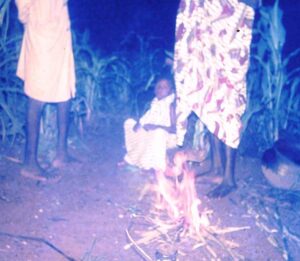
A short-lived straw fire was lit. In the background, Akapami (seated) in a festive robe (1st ed.; Fig. 25).
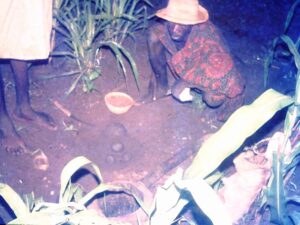
One large and three small earth balls were formed by the diviner Akai Adaatiim; behind the clay balls we can see the sacrificial knife (1st ed.; Fig. 28).
a) A wen-piirika celebration in Asik Yeri (Badomsa, 25 August 1973) [endnote 6]
When Leander’s six-year-old son Akapami was ailing and even had to visit the Navrongo hospital for a short time, he went to a diviner, who found out that the child’s wen wanted to “come down” into a bogluk [endnote 7], where a chicken should be sacrificed to it. Then, Leander was referred to a second diviner, Akai Adaatiim, who set the date for the erection of the wen-bogluk to 25 August 1973 and gave instructions that Leander’s wife should grind sprouted (germinated?) millet for pito three days after this visit. Akapami was not allowed to know what these preparations were for; he had to be in complete ignorance until the morning of the feast day. A day before the appointed one (i.e., 24 August 1973), Leander went to his house in Badomsa, and Ayomo Atiim, the ten-year-old officiating yeri-nyono, offered millet water to Leander’s father Asik; Leander’s father’s father Adeween; Asik’s and Adeween’s grandmothers (MM), whose wena were by the puuk pots in the kpilima-dok); and Leander’s mother, whose wen was by the footpath in front of the compound in or near a bogluk made of two stones [endnote 7a] (cf. Fig. 43: the genealogical overview of p. 179 as well as the location sketch chapter V3d [p. 182]). The millet in the sacrificed millet water had to be from the previous year. Only the sacrificer Ayomo Atiim and Leander, who said the prayers, were present.
During the whole night before 25 August 1973, the diviner Akai and his assistant Achang Akasilik stayed near the compound, and twice during the night, the two appeared at the compound entrance. I could hear the rattle and monotone voice of the diviner, but his activity had not come to my attention. Leander told me that the diviner had to protect the house from evil spirits. In order to be able to perform the early morning ceremony, Akai was not allowed to wash his body {147}.
Even before the first signs of dawn appeared, it was about 4.30 a.m., the diviner appeared at the compound door for the third time. He tapped his stick against the entrance cones (zamonguuni) made of clay and called three times:
Akapami nyin pielim a tuesi fi weni.
Akapami come out to the forecourt [pielim] to get your wen.
Then, Leander escorted the mother and child (Akapami) to the entrance. (It must be noted here that it was not Akapami’s biological mother who had come to Badomsa but Leander’s first wife, who has maternity rights over all of Leander’s children.) The ashes of ordinary firewood were put in Akapami’s left hand. The “mother” covered the child’s eyes with her hand. The diviner’s assistant Achang closed the diviner’s eyes with his hand, opened the gate to the compound, and the diviner blew (pobsi) the ashes in his left hand towards Akapami, while Akapami blew his ashes towards the diviner. Then, both of their faces were uncovered, and the diviner lightly struck the child’s head three times with his rattle [endnote 7b].
Before sunrise, the inhabitants and guests gathered in front of the house. They let a pile of straw (and brushwood?) burn with a bright flame without adding wood . According to Leander, this was a sign to the neighbours that something important was about to happen in this house.
The diviner and another assistant Akasilik, who also came from a neighbouring house in Badomsa and did not have divination powers himself, prepared a medicine. On the footpath where a hole was later dug in the ground, Akasilik crushed a white fibre together with pito residue (pl. da-binta; sing. da-beung) [endnote 7c]. The fibre came from a waaung-soluk tree (Annona senegalensis) whose roots are also used in some areas for the naming pot (tibiik) (cf. chapter IIIA2, p. {70}) and which was called “blessed tree” or “smooth tree” (tii saglik) by Leander {148}.
A small live chicken, whose white colour, according to Leander, was supposed to symbolise happiness and joy, was brought to the mortar to be later taken alive by the diviner to his house.
The diviner then dug a hole about 25 cm in diameter with a sharp stone in the footpath that led through a millet field (cf. Fig. 26), while Ayomo Atiim fetched water from the well in an earthenware pot. Under no circumstances was he allowed to spill any of it if the conduct of the whole festival was not to be jeopardised. The water was then mixed with the crushed fibres in a calabash and some of the excavated earth to form a loamy paste. From this, the diviner formed three fist-sized balls and one slightly larger one and placed them in the hole. In the meantime, the assistant looked for a few small stones. They were ordinary stones and not the round, white stones found in the ancestral bogluta. The diviner chose one of the stones offered to him. Then, he plucked some feathers from the white chicken’s wings and put them into the damp mud balls. In the big clay ball, he made a small hole, spat into it three times, and instructed Akapami to do the same. As Leander explained to me, this partial rite gave its name to the personal wen (tintueta-wen or “saliva”-wen) [endnote 8], for this type of bogluk, unlike the ancestral bogluta, always has the saliva of its living owner.
After spitting, the diviner took some leftover white fibres soaked with pito residue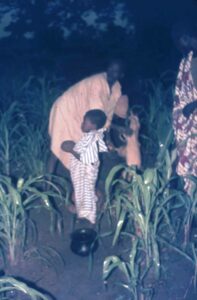 and stroked them three times over Akapami’s body: his back, neck, head, face, chest, and belly. Then, they waited eagerly for the sun to become visible. Akapami held the large clay ball in his hands (cf. Fig. 29). The sun had risen earlier, but until then, it had been hiding behind clouds. When it was exactly half visible, the diviner pressed the stone halfway into the large clay ball. This was the most important ritual of the day, for at that moment Akapami’s wen entered the stone from the solar disc. The diviner moved his calabash rattle (sing. baan-kayak; pl. baan-kayaksa) while saying the following words {149}:
and stroked them three times over Akapami’s body: his back, neck, head, face, chest, and belly. Then, they waited eagerly for the sun to become visible. Akapami held the large clay ball in his hands (cf. Fig. 29). The sun had risen earlier, but until then, it had been hiding behind clouds. When it was exactly half visible, the diviner pressed the stone halfway into the large clay ball. This was the most important ritual of the day, for at that moment Akapami’s wen entered the stone from the solar disc. The diviner moved his calabash rattle (sing. baan-kayak; pl. baan-kayaksa) while saying the following words {149}:
Akagoom zaani wa wen zaana jigi [three times]. Ni nyini maari zaani Akagoom wa ale wa wen zaani ka jigi.
Akagoom [correctly Akapami] is standing at the location of his wen. Come out [address to all present] and help Akagoom, who is standing at the location of his wen.
The Buli text was recorded on a tape by me at the wen-piirika and later transcribed into English by my interpreter Godfrey Achaw. Although the rattles make it somewhat difficult to understand, there is no reason to doubt that the text below was spoken by the diviner. However, Leander, to whom I later showed the text, claimed that the following words were spoken:
Akapami, dag fi wen zaana jigi [three times]. Ni meena nyin maa dagi Akapami wen zaana jigi ate n zaani [three times].
Akapami, show me the location of your wen [three times]. All of you, come out and also show me the location of Akapami’s wen, so that I may set it [the wen-bogluk] up.
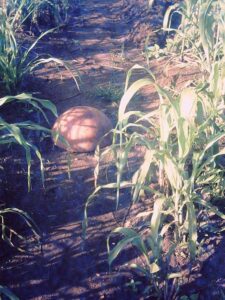 The hole dug in the ground was then covered with a large calabash bowl, under which the live white chicken and the unchosen smaller balls of earth were placed {Fig. 30}. The larger earth ball with the stone was brought inside the compound in a procession. It was carried by the child’s “mother” on her head in a calabash that had never been used before. At the entrance to the house, the diviner, according to Leander, spoke the following words again (?) [endnote 9]:
The hole dug in the ground was then covered with a large calabash bowl, under which the live white chicken and the unchosen smaller balls of earth were placed {Fig. 30}. The larger earth ball with the stone was brought inside the compound in a procession. It was carried by the child’s “mother” on her head in a calabash that had never been used before. At the entrance to the house, the diviner, according to Leander, spoke the following words again (?) [endnote 9]:
Akapami dag fi wen zaana jigi [three times]. Ni meena nyin maa dagi Akapami wen zaana jigi ate n zaani [three times]. (For a translation, see above.)
In the courtyard, the same sentences were recited for the third time by Akai.
Then, Leander showed the diviner where the new bogluk was to be placed, and the diviner pressed the damp ball of earth onto the {150} ground and formed the sides so that the new bogluk took on a hemispherical shape. Akai took off his outer garment and prepared everything for the sacrificial acts.
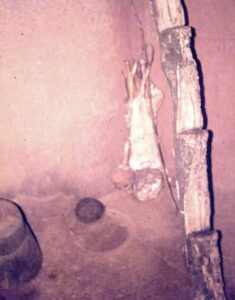
The still-damp clay ball with its stone found its position as a new wen-bogluk on a house wall behind a stepladder (tiili). To the right of the new bogluk, the instruments of the diviner were lying on the jadok stone (1st ed.; Fig. 31).
Before killing the chicken, Akai and his assistant Achang spoke the following prayers to Akapami’s wen [endnote 9a]:
Akai Adaatiim: Ma yaali ain n zaani ni nangta po kama. Ayaalege se ka wa nyinka nin yok ngololoo, ate ti seb wa yaa ale chim nur, ate ku nala. Ate ti kan ngman wom ain wa nying tuiling ya.
Kisuk ate ku ta cheen jaa paai bena ko ate ti seb nya ale wa daam sum yuen wensie, ayaalege ain dan ka daam wa ale tom diila ate taa pa va. Nyiam ale nna. Nichanoa dan jam baa tuk ka nyiam wa noi, nyiam be ale nna. Kpiak ale nna, kpa-nubi sobluk ate wa ta jam ain wa te fu. Nyiamu nna moong (wa) noi ya. Goom due ate wa nyinka yok ngololoo ate n seb nya ka fi ale la, ate wa chim nur.
Achang Akasilik: Ain taa ale yuen diila taa yueni ka dila, biam jam boro bu boka tama me dek jigi. Alege tama me dan lak ka poi a tom taa me a yaali ka poi peentik. Ate ti nya ale biika nyinka yok nalem nyini ate wa yiti maa bo wa chaab po. Ale fi dan biak biik ate wa joe kinkangi a nyini, fi basi kama. Wa me dan sum boro wa tuesi wa kpiaka ate ti nya. Ti ka wari a gaam dila. Tama nisapo wani ale la.
Akai Adaatiim: Yaa! Biik tee a nyeka ye kpeensa. Fi kpiaka ale nna. Biika nisa ale nna. Ain dan ka wensie ate fi soa nyinka tuilinka, ta yueni ka nyinka tuilinka, wa wa peenti ka fi. Wa kpiak ale nna. Kpanubi sobluk ain n vi fi zuk ate fu, fi wari ale a la, ate wa nyinka yok ngololoo, ate ti seb ain fi sum tuesi ngoa; daam ale nna ate ta ti sugri ziimu a basi ate ti nya wa nyinka a leka dii. Ti ale nya ale wa nyinka a yogsa, ate ti nya wapaala. A nya ale wa me chala a tam ate ti kan ngman gisi wa genga. Ngoa! {151}
I wish to stand at your feet [i.e., before the bogluk]. But only when his [Akapami’s] body becomes cold [when he becomes healthy] do we know that he becomes a man, and that is good. And we don’t hear again that his body is hot [that he is ill].
Today and a hundred years from now, we will know and see that it [the wen] once really spoke the truth. But if it used to be so [in the past] it is done today; then we follow [do the same]. This is water. When a stranger comes, you give water to his mouth [tuk nyiam; lit. to catch water running from a roof]. This is water. This is a chicken, a black female chicken, which he [Akapami] brings to give to you [the wen]. Here is the water, [take it and] wet your mouth. Sleep well [lit. down] so his body may become cool, and I know and see that it is you and that he [Akapami] will become a man.
Achang Akasilik: Yes, we who said this, said so [i.e., it is true]. If there is any evil, it is with ourselves. But if this is also true [lit. when we open our stomachs to work], we also desire joy [lit. a bright stomach] and we see that the child’s body becomes cool enough. He [Akapami] gets up and is with his playmates. If one [lit. you] gives birth to a child and it climbs over the inner wall of the compound and comes out, one certainly allows it. If it [the wen] is really here, it gets its chicken, and we shall see. We have nothing more to say. It is the thing in our hands [i.e., now the chicken must be sacrificed].
Akai Adaatiim: Yes! Talking for a long time does not create anything big. Your chicken is here. The child’s hand is here. If it is the truth that you [the wen] are the cause of the heat of the body and we are talking about the heat of the body, the truth will be revealed to you. This is his chicken. A female {152} black chicken that I am putting on you for you. It is your business that his body becomes cool, and we know [then] that you have really accepted [the sacrifice]. Here is Pito so that we can wash off the blood and see how his body is. We see that his body becomes cool, and we see new things. And we also see him [Akapami] walking around, and we don’t think about his [sick] appearance again. Take it [the sacrifice]!
According to Leander, who checked the transcript of Godfrey Achaw’s transcription from the tape and its translation, Achang also spoke the following words [endnote 10]:
Dila nying, Akapami nya wen jinla de, taa poli Naawen peeluk kpiongku ale te biika nying yogsa. Wensie me dan sum boro, wen pieni ale tengka, ale tangabana, ale kpilima meena, maari a te Akapami.
That is why Akapami sees his wen today. We believe that the white great God [Naawen] gives health to the child. If this is really the truth, the great God, the earth, the tanggbana, and all the ancestors are helping Akapami.
The form of speech chosen here ABA is quite common in such matters – i.e., usually, one speaker (the diviner) begins and is interrupted by another (here, the diviner’s assistant), and finally, the first speaker continues his thoughts in a third part.
Following the prayer, the diviner offered millet water to the new bogluk, and thereafter, a fat, dark chicken was decapitated. After this, it fluttered for a longer time and finally lay still on one side – i.e., the wen had accepted the sacrifice [endnote 11]. The diviner was not allowed to eat anything from this chicken. Therefore, a guinea fowl was prepared for him as a friendly gift, but it had no sacred function.
Of the three [endnote 12] clay pots with pito that stood in the inner courtyard, the small and medium ones were used for the sacrificial purposes of that day and for entertaining the guests, while the large one was given to the diviner as a {153} gift. From the small pot, pito was poured into a calabash and offered from this calabash to the Akapami’s wen. The rest was distributed among those present. The millet beer offered there was not fermented in order to symbolise (according to Leander) Akapami’s childhood. As Leander did not like unfermented pito, he did not take part in the sacrificial meal, while I was offered a calabash of this pito.
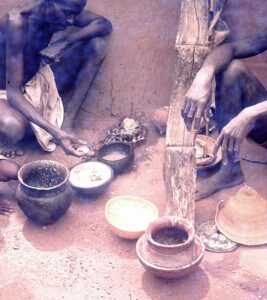
In the afternoon, meat, TZ, and gravy were offered to the new bogluk by the diviner (left), (1st ed.; Fig. 32).
After this, there was a break of about an hour in the ritual events, during which the women of the house prepared the dark chicken and TZ, which the diviner was not allowed to eat, and a special meal (with guinea fowl) for the diviner. Around 10.00 a.m., the diviner offered clear water, TZ, some meat, and the liver of the now-cooked black chicken to the new wen-bogluk. After this, fermented millet beer was offered.
The diviner and his assistant then retired to the kpilima-dok for a complete divination session to explore whether everything had been done properly. When the result was positive, Leander thanked the diviner for his efforts.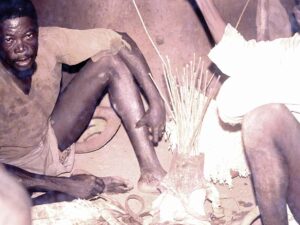
In summary, all the gifts or payments that the diviner received in the course of the day or was receiving while parting are listed here once again:
1. A basket of ungrained panicle millet (zamonta) from the previous year
2. The live white chicken used by the diviner in his house for sacrificial purposes
3. A part of the cooked black chicken from which some meat and the liver were sacrificed and from which Akapami received a thigh
4. A large pot of pito
5. A live brown chicken that the diviner could use for any purpose
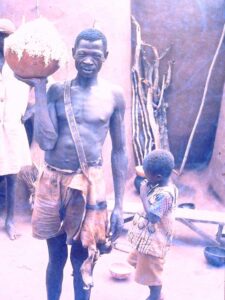
Shortly before leaving, the diviner (back left) received his payment. Achang helped him carry the calabash with sorghum (zamonta) (1st ed.; Fig. 34).
Finally, Leander, in his capacity as Akapami’s father, sacrificed pito (through Ayomo) to the female ancestors Abandemlie and Aguutabe in the kpilima-dok, his father and grandfather in front of the compound, and his mother (two-stone-bogluk on the way) {154}.
Three days after the wen-piirika rites, Leander showed his son Akapami how he had to sacrifice to his wen from then on. This sacrifice is called tu-poak-laka (opening the baobab shell) [endnote 12a]. Since then, all offerings to the new wen-bogluk were made by Akapami himself. Adults could give instructions but were not allowed to interfere with the offering.
b) Additions by other informants (before 1978)
In contrast to the information on naming, there was significant consensus among the various informants who offered information about the wen-piirika, although none of them could report as many details as I could record through my own observations, tape, photos, and notes.
The timing (August) of the wen-piirika described above can be considered somewhat unusual. It is true that the erection of a wen-bogluk is not bound to any season because diseases and educational difficulties can occur at any time. However, there are some reasons that make this ceremony more acceptable for the dry season (November to April). Not only is a day lost for fieldwork in the rainy season, but also, above all, the need for direct contact between the wen stone and the sun’s rays adds a great deal of uncertainty in the rainy season. I have heard that a whole festival party often waits for hours in the rainy season for the sun to become visible, and sometimes, after waiting in vain, the sacred act has to be postponed by the diviner to another date.
If, in the wen-piirika described above, the main cause for the establishment of a wen-bogluk was an illness of the child, it is also not the only reason. Just as often, educational difficulties seem to lead to the creation of a bogluk. For older people, failures at work, constant threats, quarrels, misfortunes, and so on can also cause the establishment of a wen-bogluk.
Abang, a man of about 25 years from Wiaga-Kubelinsa, told me about the trouble he caused his parents before {155} his wen got a bogluk. He killed his father’s chickens just for pleasure. Once, when he had to ensure that no animals went to the sprouted millet, he beat a goat who wanted to eat the millet so badly that it died. The father then went to the diviner, who found out that the boy’s wen needed a bogluk. On the evening before the feast day, Abang already wanted to drink from the sacrificial pito, which of course could not be allowed, as his wen was to taste it first. Therefore, that very evening, the boy ran away from his parents to a friend’s house. The father lured him back under the pretext that he wanted to slaughter a goat, and Abang had to hold it while he did so. When the boy expected a roasted goat, he came back. However, the goat could not be slaughtered that same evening, and early the next morning, the boy heard the rattles of the diviner. Ash blowing (pobsika), according to him, did not exist in Kubelinsa on this occasion; however, he remembered the three stick (rattle?) blows of the diviner well. The rest of the wen-piirika rites took place in Kubelinsa in the same way it did at Leander’s house.
According to a Sandema-Longsa source, the youngster getting the bogluk is always required to fetch a calabash full of water to make the clay paste.
While doing so, the child is only allowed to scoop once (according to other information, only with his left hand) and is not allowed to spill any water on the way. Leander also knows this provision. However, he thinks that someone else (e.g., the yeri nyono) can also fetch the water if the child is still too small or too clumsy.
Atiinka from Sandema-Kalijiisa gave a detailed account of the day he received his wen-bogluk in his life story. The correspondence with the above-described ritual sequence of the wen-piirika in Leander’s house is astonishing, considering the wide variation in naming rites in the Bulsa area. Even the prayer of the diviner to the child’s wen shows similarities with that of the diviner Akai {156}:
… the sacrificer said that this was my personal god who had come down to me. So it was a true god, who should help me with illness and everything I grew up to do.
In all the accounts of wen-piirika celebrations, the events and conflicts that lead the father to seek out the diviner for his son are very revealing. A special study on educational conflicts among the Bulsa could very well start with the motivations for a wen-piirika. Atiinka reports the following from the prehistory of the establishment of his wen-bogluk:
I didn’t like my father, because he always quarrelled with my mother. Because of the quarrels my mother left me and married away. The time my mother married away I took a bow and arrow to shoot my father to death, because he drove away my mother. All that time my father was on the look-out, because he did not really know what was in my mind.
One day in the night they gave me food that wasn’t sufficient for me, so I took my bow and arrow and aimed it at him but one of his wives was watching me and she shouted out to my father to wake up; he woke up before I pushed out my arrow. Luckily it was on his tie. That very night he went to a fortuneteller (diviner) and brought the news that it was my personal god who wanted to come down. That was why it was worrying me like that.
c) Supplements after 1974
After 1974, I had the opportunity to participate in ten more Bulsa wen-piirika rituals. Most of these took place during my research stay in 1988–1989. The diviner Akanming, whose compound was close to my compound Anyenangdu Yeri, decided to train me as a diviner (baano) after all his sons had refused such a job. He, therefore, gave me regular lessons in his divination room (jadok-dok), in which he explained to me, for instance, the meaning of the symbolic objects in his divination bag (baan-yui) and asked me about them during the next session.
I was also to learn how to perform a wen-piirika by taking part in all the rituals of this kind that he performed. To his annoyance, I missed three of all the wen-piirika rites he performed in 1988–1989.
Since the wen-piirika celebrations listed below were, to a large extent, similar to those described above for Asik Yeri, the following list contains only the external data (the time, compound, and occasion for the ritual, among others) as well as deviations from the 1973 wen-piirika described in detail.
1. Asik Yeri (Badomsa), 21 August 1981: The second wen-piirika for Leander’s son Francis Afarinmonsa by the diviner Akai (Badomsa)
Francis had already received his wen-bogluk some years ago, but according to Leander’s testimony, he continued to show signs of mental confusion. His conversations soounded bewildered; he did not eat and lost weight.
In a divining session with the diviner Akai, it turned out that Francs needed a second wen-bogluk. According to my previous knowledge, two bogluta are built when two suns are seen in the sky at sunrise. Here, however, the second shrine is probably meant to increase its effect against a disease.
This time, I spent the night before the ritual in Asik Yeri, and I heard the rattle of a diviner outside several times. Leander told me that Akai had to protect the compound from evil spirits during the night.
The soil in the hole was moistened with the da-puusa liquid and roots. Three feathers were plucked out of the white chicken and put into the three small balls of earth to the right of the calabash. The small clay pot with millet beer is on the top right.
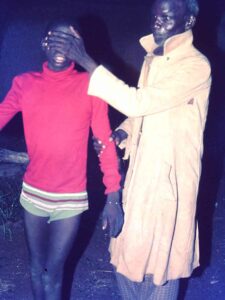
Leander Amoak and his son performing the pobsika
At around 5.00 a.m., Akai’s voice was heard three times in front of the house: “Nyin pielim, ngoa fi wen” (Come out and receive your wen). The first time, Leander replied, “Francis kan nyini” (Francis does not come out). The second time, he replied, “Nya ka wie le boro ate wa kan nyini” (See, there are problems because of which he is not coming out). The third time, he replied, “Ka zaana ale boro” (there is a difficulty).
The following partial rites (leading out, hitting the boy with the rattle at the entrance, and blowing ashes, among others) were similar to those described above.
There was a discussion about whether the earth for the shrine should be dug at the footpath leading to Francis’ mother’s parents’ house (in Wiaga-Farinsa) or his mother’s mother’s residence (in Kadema). Only at the last minute did the diviner determine that it should be the latter.
After burning the straw, making one big and three small clay balls from the earth dug out of the hole and the waaung-soluk root medicine, and pressing the stone into the mud ball, everyone moved into the house where rites and sacrifices similar to those in 1973 were also performed.
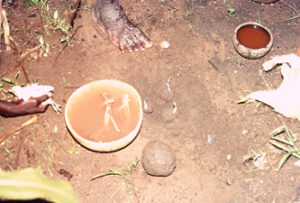
The soil in the hole was moistened with the da-puusa liquid and roots. Three feathers were plucked out of the white chicken and put into the three small balls of earth to the right of the calabash. The small clay pot with millet beer is on the top right.
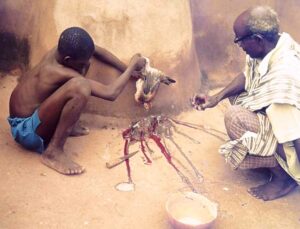
Depicted here is the tu-poak sacrifice. Three days after the wen-piirika, Francis sacrificed on his own to his two new shrines in the presence of his father.
2. Anyenangdu Yeri (Badomsa), 16 October 1988: The wen-piirika held for Anamogsi’s daughter-in-law, Apuyiilalie
She had been ailing for a long time and visited her parents’ house in Wiaga-Chiok to recover. There, her father went to a diviner who ordered a wen-piirika (in Anyenangdu Yeri), which was necessary for healing.
Deviating from the rituals described so far, this wen-piirika was not performed by a diviner but by Anamogsi, the compound head and father-in-law of the woman concerned. The femininity of the wen recipient found expression in the fact that threefold actions in the earlier rites were now replaced by fourfold actions. For example, four small clay balls were made, and the young woman had to spit four times into the hole of the wet clay ball. Anamogsi also gave me a plausible explanation for making the small and large clay balls. There are two different components of wen: wen-biok (the evil wen) and wen-nalung (the good wen). The evil wen in the four small balls had to be separated from the good wen in the large ball and discarded (cf. Kröger 2020).
Anamogsi found the wen stone only after the large, damp clay ball had already been made. He opened it with a larger stone and found the small stone inside, which was to serve as an offering stone from then on. Instead of rubbing the body with a root fibre and da-binta, as is customary in the baano-wen ritual (performed by a diviner), Anamogsi poured clear water from his hand on his daughter-in-law’s hair four times.
Apuuyiilalie carried her new shrine herself to the compound, where it found its place in her bedroom in her husband’s quarters. There, the husband offered it a chicken and, in the evening, clear water, millet porridge, and boiled chicken meat, while Anamogsi said the prayers.
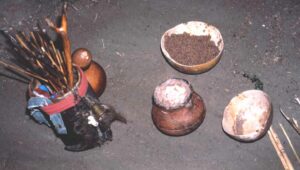
Awenlami Yeri: On the footpath, there were a small pot of millet beer (next to the calabash lid), da-buusa in a calabash bowl, and the diviner’s tools.
3. Awenlami Yeri (Wiaga-Longsa), 8 December 1988: The wen-piirika performed by the diviner Akanming (Badomsa)
On 7 December 1988, Asoji, the yeri-nyono of Awenlami Yeri, announced the wen-piirika of a woman for the next day in Akanming’s compound.
In front of the Awenlami Yeri, Akanming asked me to switch off my torch. The pobsika with the woman at the compound entrance was performed by Akanming’s son Ajacke. This proxy is possible because the pobsika is actually not performed by Akanming the diviner but by the spirit of his rattle. Akanming, who was somewhat disabled, arrived later. The following acts differed somewhat from those of Asik Yeri and Anyenangdu Yeri. In a calabash, a woman brought a reddish residue (da-busing) from pito making, which was diluted with clear water. Akanming threw into the red mass a dark red root fibre brought from a tree whose roots reached into a river. From white kazagsa fibre, he formed a carrying pad (tuilik) for a small clay pot filled with pito. That this was a ritual and not a practically necessary activity is shown by the fact that this action was also carried out in exactly the same way in all subsequent wen-piirika rituals performed by a diviner, and the fibre ring was later disposed of in the hole with the other “bad” things. Akanming told me that he was not allowed to tell me about the ritual significance of this ring. Perhaps the evil components of the millet beer had also been drawn into this ring.
Akanming then scraped up the soil on the footpath with a hoe and poured water into the resulting hole. He formed a rough bowl from the excavated earth, poured some millet beer into it four times, and mixed and kneaded it with the earth.
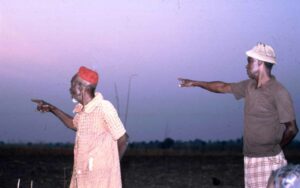
In front of Awenlami Yeri, part of the sun became visible between two trees in the haze of the morning.
When the sun became visible behind a layer of clouds, he formed one large and one (!) small ball from the earth and put four white feathers from a small chicken into the small ball. He then rubbed the woman’s body with the white chicken. According to Akanming, all evil and guilt (wa-kaasima) passed from the woman to the chicken.
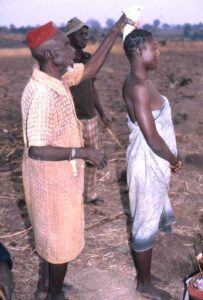
Akanming rubbed the woman’s body with the da-buusa and the white chicken.
He pressed a hole into the big ball, and the woman spat into it four times. Then, Akanming pressed a stone he had brought from home into the clay ball; he said that it symbolised the sun (wen-bini).
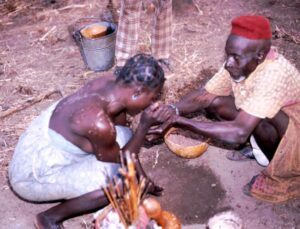
The woman is spittiing into the hole of the stone four times.
After the procession to the compound, Akanming held the clay ball three times over the intended location and only pressed it firmly on the ground the fourth time. Before sacrificing a brown chicken, the woman had to touch its foot, and the chicken had to drink some millet beer from Akanming’s finger. Then, Akanming sacrificed a guinea fowl and some millet beer from a small calabash. The two chickens were later cooked, and pieces of their meat and liver were offered to the new shrine along with millet porridge.
The meat of the two chickens was divided according to fixed rules: one leg of the guinea fowl (kpong) was given to Asoji’s mother, who owned the courtyard, and one leg to Asoji, the compound head. The wife of the compound head received one wing of the guinea fowl. The husband of the shrine recipient (?) received the second wing. After making long speeches of thanks and drinking millet beer, a diviner’s session took place, resulting in all rites being performed correctly. Only after this did the greetings take place between the guests and housemates of Awenlami Yeri. As payment, Akanming received: the small white chicken (for his son Ajacke, who was not allowed to eat it himself, as it was loaded with the woman’s debt); one bunch of zamonta; one calabash of unginned peanuts; one jug of millet beer; the rest of the two sacrificed chickens; one chicken as an offering for his divining spirit (jadok) in Badomsa; and a chicken for me. Earlier, a woman had brought a large jug of millet beer to Akanming Yeri, which was shared among the residents of this compound in the evening.
After returning to his compound, Akanming made offerings on the roof of his divination room (jadok-dok) to the following shrines: the earthen crocodile sculpture (the actual jadok shrine), the wen of the jadok, three medicine horns (his jadok’s horn, the tongnaab horn, and his father’s Pung Muning horn), and the large medicine pot (front left).
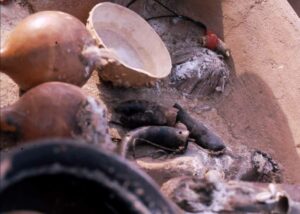
Sacrifice on the roof of Akanming’s divination room
4. Ateebnaab Yeri (Wiaga-Mutuensa), 30 December 1988: Wen-piirika performed by the diviner Akanming (see above)
On 29 December, before this wen-piirika, I was able to participate in the previous day’s offerings, in which Akanming informed important supernatural beings of his household about the following day’s event. He offered millet water (zom) to the following bogluta: his father Awasiboa’s ancestral shrine in front of the compound, his mother’s ma-wen (two stones [endnote 12b] by the footpath), his two horns with the soil of the tanggbain Pung Muning (Badomsa), his own tintueta-wen, his divination jadok (ngauk; crocodile), a clay relief on the roof of his divination room, and at the same time its accessories (the two divination rattles, two filled horns, divination bag, associated medicine pot, and other objects).
The yeri-nyono of the Ateebnaab Yeri compound, a middle school graduate and practising Catholic who had previously worked at the Wiaga Catholic clinic, could not actively participate in some rites (e.g., the final divination session) as a Christian. His son, who was about one year old, suffered from shortness of breath and convulsions.
The following rituals were very similar to those in Awenlami Yeri (no. 3). Minor deviations resulted from the young age of the shrine recipient. He could not spit into the clay ball, but his saliva was pressed into it three times with his father’s finger. A similar procedure was followed when, later, the little boy had to drink (or rather lick) millet water from his father’s finger. Inside the compound, a large black chicken was sacrificed this time. The new shrine was carried into the compound by the child’s father. The welcoming ceremony again took place after the divination session.
As payment, Akanming received a large pot of pito, which a woman brought to Akanming Yeri; a large calabash of zamonta (sorghum) millet; a grey chicken; the small white chicken; and as a voluntary gift, another cooked guinea fowl.
At about 1.00 p.m., we were back at Akanming Yeri. Here, Akanming once again offered first millet water and then millet beer to his jadok (with accessories) on the flat roof. The diviner’s rattles did not receive an offering this time. (He had probably forgotten them.)
5. Akanjoliba Yeri (Wiaga Mutuensa), 5 January 1989: The wen-piirika performed by the diviner Akanming.
(The events in this compound were documented mainly on a video film.)
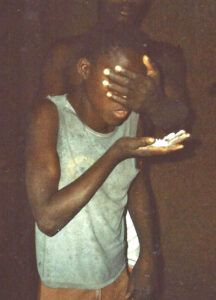
Pobsika at the entrance of the compound
The shrine recipient was a girl of who suffered from mental confusion and could not converse normally. This was also shown in the rites by Akanming taking hold of her head on the footpath before the rites began and massaging her head with a hand in which he held medicine.
Both the preparatory sacrifices on 1 January in Akanming Yeri and the actual rituals in Mutuensa were very similar to the previous two (3 and 4).
A small, somewhat embarrassing incident preceded the wen-piirika. Again, Akanming had sent his youngest son Ajacke and me ahead to perform the pobsika. Unfortunately, we had rattled at the wrong compound, and Akanming, who had rushed over, had to explain the mistake to the excited inhabitants.
6. Abasitemi Yeri (Wiaga-Badomsa), 13 January 1989: The wen-piirika performed by the diviner and yeri-nyono Ayomo
Ayomo’ father’s father had moved from Gbedema to Badomsa, his mother’s lineage. This might be the reason that some rituals differ from those observed in the Badomsa patrilineage.
The shrine recipient of this wen-piirika was his newly married blind wife from Kadema.
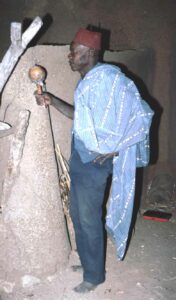
Ayomo is rattling in front of his own compound
I had been waiting in front of the compound since 5.20 when Ayomo came rattling to the main entrance from the back of the compound at 5.45. He fetched some light ash from one of the fireplaces and performed the pobsika at the entrance with his wife (who, of course, did not have her eyes covered). This time, the ritual of the burning fire on the footpath leading to the wife’s parents’ house was not carried out.
Similar to what Akanming did, Ayomo pounded two pieces of root in a mortar and mixed them with the red da-buusa pito residue. It was somewhat extraordinary to me that after the sun appeared, he first started forming four small clay balls (for the four white feathers) and the large ball into which his wife spat four times. He only pressed the stone into the ball inside the house. A discussion ensued about where the new shrine should be located, and the decision to place it in Ayomo’s own square building was again somewhat unusual. The offerings were again in line with the way I knew them: millet water, one dark chicken, one guinea fowl, and millet beer were offered to the new shrine but also to Ayomo’s divination bag and rattle, after the woman held or at least touched them. After the midday offerings (water, chicken, millet porridge with sauce, water, and millet beer), the divining session took place not in Ayomo’s divination room (jadok dok) but in the room of the new shrine. Afterwards, the following shrines received a pito offering: the new chameleon shrine built a few days earlier at the main grain store of the courtyard, the divination bag with the rattle and the jadok horn, and the shrines of Ayomo’s ancestors at one side of the compound. Only at 5.00 p.m. did he make offerings to the Pung Muning horn and four jadok shrines in the middle of his courtyard. Then, the thanksgiving took place. Payments were not offered, as all the main actors were from Ayomo’s own compound.
7. Angaung Yeri (Wiaga-Kubelinsa), 30 March 1989: The wen-piirika performed by the diviner Akanming
The shrine recipient was a wife who was considered quarrelsome and had caused several conflicts in the compound.
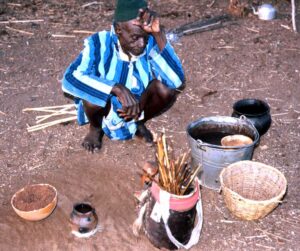
Akanming’s preparations for the upcoming rituals. Behind Akanming are the millet stalks with which he cleared the path. In front, from left to right: a calabash with da-puusa (pito residue), a small clay pot with pito (part of it will be inserted into the earth ball later) a ring made of white fibres, the divination bag, a basket for covering the chicken later, water (in the bucket with a scoop calabash) for mixing the clay for the earth ball, and a cheng pot with pito (for offering, see below).
After the first rites were conducted in a manner very similar to those of earlier wen-piirika celebrations, the ritual of rubbing the woman was much more elaborate this time. Akanming held the white chicken and the da-buusa with roots on the head of the woman standing in front of the hole and said a prayer. He rubbed the woman’s whole body with the things in his hand: chest, thighs, legs, head, back of the head, back, buttocks, legs, lower legs, both arms, and both hands. Then, he passed the chicken and da-buusa around both feet and pressed the chicken firmly into one of the woman’s hands. The woman squatted down, and Akanming handed her the clay ball with an indented hole four times. She spat into it each time, and Akanming kneaded the ball. Only then did he press the stone he had brought with him into the big ball of clay, separate part of the big clay ball into a small ball, and placed it in the hole before inserting the four white feathers.
The woman carried the new shrine into the compound to the sound of Akanming’s rattling. After the usual offerings to the new shrine, we went to the open kitchen of the main courtyard (dabiak) where we were shown three jugs of millet beer. The smaller one was immediately poured out for drinking, while a woman of the compound carried a larger one to Akanming Yeri. The midday offerings and also the payment to Akanming were again exactly like the earlier wen-piirika rituals.
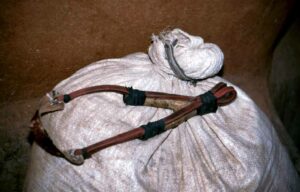
The boy’s catapult
8. Atinang Yeri (Wiaga-Badomsa), 13 February 2001: The wen-piirika performed by the diviner Akaateba (residential section: Wiaga-Goldem; natal section: Wiaga-Zuedema)
The shrine recipient was a boy of about five years, a grandson of Atinang, the compound head. The little boy had been shooting at chickens with his catapult and also at people. Now, he believed that he would be punished for his evil deeds in the following ritual, and therefore, he screamed and cried during all the rites. The catapult itself was clearly displayed.
In contrast to the wen-piirika rites described above, Akaateba formed two small mud balls (Akai: 3; Akanming: 1) next to the large ball. After the offering in the house and before the final divination session, the diviner was given a brown chicken and a smaller calabash of sorghum. A large pot of millet beer had already been brought to his house in Goldem beforehand.
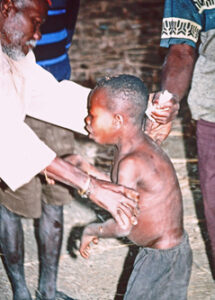
The weeping boy is rubbed with a white chicken
9. Anyenangdu Yeri (Wiaga-Badomsa), 12 January 2003: Wen-piirika performed by the compound head Anamogsi
The shrine recipient was Anamogsi’s granddaughter, who was about three years old.
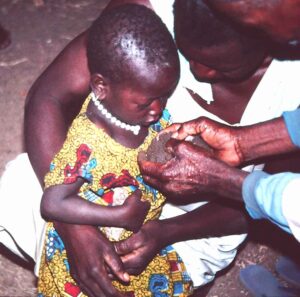
The girl’s saliva is inserted into the clay ball
Since all those involved in the rite lived in the same compound, the pobsika did not take place at the entrance to the compound but at the entrance to the sleeping room of the girl’s mother. The hole in the ground was dug in the front yard (pielim) of the compound, and Anamogsi formed a ball of earth, which he opened three times, finding a small stone each time. He formed two small earth balls and one larger one from the earth mass and pressed one of the found stones into each ball. After the sun had become visible, the child was supposed to spit into all three balls of earth, but Anamogsi only pressed some of the girl’s saliva into the big ball with his finger and then washed his own hands and the child’s head, hands, and feet with clear water. Then the mother carried the child and the new shrine into the house. Before the sacrifices, the child had to touch the sacrificing calabash with millet water and the chicken. Around 7.00 a.m., everything was finished. The midday offering (cooked meat and liver of the chicken with millet porridge, ochro sauce, and clear water) took place around 1.00 p.m. I was served a full lunch with the rest of the millet porridge.
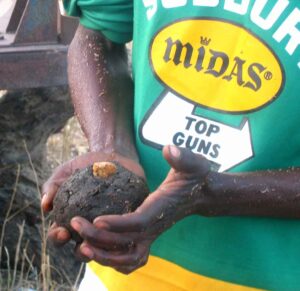
Ankaasidi is carrying his new personal shrine
10. Anyenangdu Yeri (Wiaga-Badomsa), 5 February 2008: The wen-piirika performed by a diviner
The shrine recipient was Anamogsi’s daughter’s son. What was extraordinary about this wen-piirika was that the first wen shrine was given to a young man who did not belong to the lineage of the compound head. His mother had returned to her parents’ compound after an unsuccessful marriage and had brought her children with her. (The latter is also somewhat unusual, as children usually stay with their father’s family.)
This time, the rites were not performed by Anamogsi but by a diviner in a greatly shortened overall sequence. For example, the shaping of the smaller balls was omitted. I failed to ask whether these abbreviations could be explained by the shrine recipient belonging to a foreign lineage.
d) Locations of the wen-bogluta {156}
The wen shrines of the people in one’s own lineage (e.g., sons, daughters, and grandchildren of the compound head or others) are usually placed in the courtyard of the mother of the wen shrine owners. The bogluta of married women find their places in their bedrooms.
However, there are exceptions to this rule. In Asik Yeri, Leander’s traditional compound, all the bogluta and other shrines are united in the courtyard of Leander’s late elder brother Atiim and his still-living wife {157}. In this courtyard (Ama-dok), there is also the dalong or kpilima-dok. The only sanctuary in Leander’s own inner courtyard is the tomb of his biological mother. The reason for this may be that Leander’s four wives do not have their own sleeping quarters (diina) in the traditional compound, and it would be unthinkable to erect shrines in their modern home at the centre of Wiaga.
The map of all the bogluta in Leander’s house (p. {182}) provides information on where the wen-bogluta of living people are located. On p. {185} (chapter V3d), all the wen-bogluta of living persons in the yeri-nyono’s courtyard of Amoanung Yeri have been recorded in a site plan. The locations of the wen-bogluta of the other compound inhabitants (there are two other households) became known to me only in part, although the yeri-nyono willingly gave me information about the wena of the ancestors in front of the house.
e) Sacrifices and accessories of the shrines
If the child who has received a wen-bogluk continues to cause educational difficulties or is still ailing, the diviner can find out that the child’s wen needs a sacrifice and also indicates the exact type of sacrifice.
The purpose of any sacrifice is to provide nourishment for the wen (or another bogluk). In important matters (e.g., most rites of passage), animals are sacrificed. In the first part of such a sacrificial act (usually in the morning), the wen is offered millet water, the blood of the animal, and (if there is no afternoon sacrifice) meat and liver roasted on an open fire. Of sacrificed mammals (pl. dungsa; sing. dung), only blood is offered in the morning. The meat and liver are cooked by women in the compound, and parts of this are offered to the same shrine in the afternoon together with millet porridge and a sauce.
The following liquids, foods, and animals can be used as sacrifices:
1. Liquids and food
Water: This may be offered to initiate the sacrificial act, almost always before the offering of cooked (roasted) meat, TZ, and soup (jenta). Leander gives the following explanation for it: “… so that the wen can wash its hands.” The Bulsa, too, wash their hands with water from a calabash before every hot meal (meat, TZ, soup, and so on).
If the sacrificer only wants to give the wen some information {158}, water can be offered without any food (“… that the wen may awake”). In addition, placing the right hand on the stone serves the same purpose.
Millet water (zom, a mixture of water and millet flour) can be offered before all other sacrifices but also alone. Most shrines want millet water made from grains that have been roasted before grinding.
Blood (of the sacrificed animal)
Pito (daam): This is usually offered after bloody animal sacrifices on a different day to cleanse the eyes of the spirit from clotted blood.
Soup or gravy is usually offered with TZ. According to Leander, peanut and ochro soups are most often sacrificed and bogta (a slimy soup) and tue (bean soup) less frequently . Tueta (bean leaf soup) and alefu (a leaf soup that is probably introduced from southern Ghana) are never sacrificed.
TZ (saab) is usually offered after a blood sacrifice with the cooked sacrificial animal.
Meat and liver (boiled or roasted) are sacrificed only if the blood of the sacrificial animal has already flowed over the bogluk.
Akpeteshi (palm brandy) has only been sacrificed sporadically in recent times.
Note: A slimy bogta soup can be poured in front of the bogluta without it being regarded as an offering. This act is called piirika. It is symbolically supposed to “smoothen” everything – i.e., problems are supposed to be removed. Evildoers are supposed to slip on the slimy soup (isolated information).
Millet seeds are sometimes placed on the shrines before the first sowing. However, this is not considered a sacrifice.
2. Sacrificial animals [endnote 13] {158}
Hen (kpiak) or cock (kpa-diak)
Guinea fowl (sing. kpong, male or female, pl. piisa)
A dog (sing. biak, male or female) is sacrificed only to particular shrines (e.g., tengkuk, juik, and so on).
Goat (sing. buuk, male or female, pl. bue)
Sheep (sing. posuk, male or female, pl. piisa)
Cattle (sing. naab, pl. niiga; includes cows, calves, bullocks, and bulls)
Donkey (sing. boning, pl. bonisa): As this type of animal is not accepted by most tanggbana, donkeys are sacrificed as a substitute to another earth shrine – e.g., to a tengkuk.
Goats, sheep, and cattle are grouped under the name dung (pl. dungsa). Dung is often inaccurately translated as “animal”. Sometimes, the sacrifice of a dung animal is prescribed (cf. p. 253), whereby the sacrificer is free to choose which of the three animal species he wants to sacrifice.
Animals not originally bred by the Bulsa (horse, turkey, duck, cat, and so on) cannot be sacrificed [endnote 14].
Note: Wild animals are generally not sacrificed. If a wen asks for a bush guinea fowl, it is already killed in the bush, and only the roasted meat is placed on the shrine.
3. Accessories
{159} Apart from the actual sacrifices, which end with a sacrificial meal for all present and thus create a close connection between the living and the wen of the living or the dead, a wen may also ask for other things from daily life. The following are probably among the most frequent wishes of the wena:
Cowries (lig-piela): They are supposed to correspond to the jewellery needs of the wen. Two cowries on a bogluk can also represent the wen‘s eyes (inf. also by R. Schott).
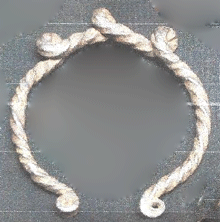
Bang gbing
Iron bangles: They also correspond to the jewellery needs of the wen. One informant reported that the ring on his personal bogluk is meant to prevent the soul from wandering (chiik). This individual piece of information could not be backed up by further evidence.
Knife (gebik): In one case known to me, the wen of an ancestor demanded a knife in order to better protect the inhabitants of the house. A flat piece of iron, which has no obvious resemblance to a knife, is embedded in the clay base of an ancestral shrine. Since the whole compound is to be protected, this accessory is probably found only in shrines in front of the compound.
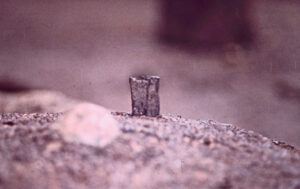
Ancestral shrine with a “knife”
A red cap (zutok moaning): This is a symbol of a chief and is supposed to mark the special position of a wen among the others.
For the protection of its owner’s health, a person’s wen may claim medication in a clay pot or loose bits of root (see also segrika medicine in a tibiik pot adjacent to the shrine).
In Wiaga-Zamsa, next to what are perhaps the oldest shrines in Bulsaland, the ancestors demanded some empty beer bottles for fetching water from a nearby pond (cf. Kröger 1982; Appendix Plate 18).
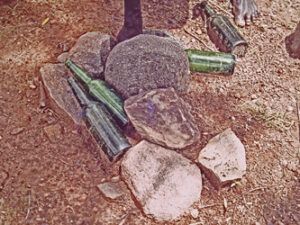
Anaanateng Guuk (Zamsa): Shrine with bottles
In front of Avarisi Yeri (Zamsa), small clay replicas of round houses, similar to those found in the compounds, were built on an ancestral shrine. Here, the ancestors can rest or shelter from the sun’s rays. I was told that there is a bedroom and a dining room.
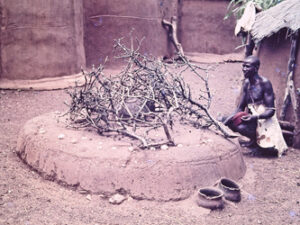
Ancestral shrine in front of the Avarisi Yeri (Zamsa). The thorny branches are meant to keep animals from destroying the small structures.
In addition to the objects desired by the spirit, there are also those that were used before or during sacrifices – e.g., the rope with which an animal was tied. This accumulation of objects is typical for earth shrines but also occurs at important medicine shrines. At the famous Pung-tanggbain of Kanjaga, dozens of clay vessels were laid down and strongly influenced the outer appearance of this shrine.
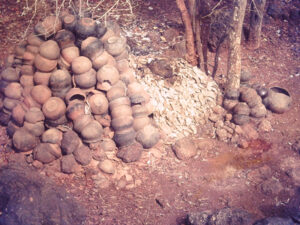
Pung-Tanggbain, Kanjaga with vessels deposited after former offerings
Ayongbiik, the youngest son of Leander’s deceased brother Atiim, continued to cause his parents educational difficulties even after the establishment of a wen-bogluk, which indicated a very strong wen. According to diviners, the wen demanded kauri jewellery for his bogluk. The cowries (three times two cowries) were attached to the bogluk in the following arrangement:
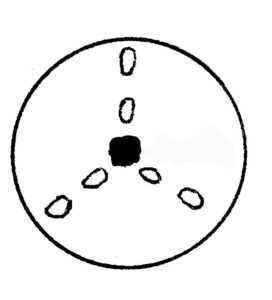
Wen-bogluk (top view)
If the child’s wen continues to cause trouble, the bogluk may even get the red cap – i.e., the boy’s wen will take a kind of chieftaincy {160} among the other wena of the house. This would be possible even though Ayongbiik was only two years old.
Lucky Akanbe Leander (cf. p. 65 ff., chapter) was given a wen-bogluk immediately after his naming, and this was done instantly with three cowries and a medicine pot (tibiik) with roots next to the bogluk. The roots were found in the following ways: The diviner instructed Leander to go into the bush until he came to a crossroads under which there were roots. He was to dig up these roots and put them in a small puuk pot next to Akanbe’s bogluk. Another wen-bogluk in Leander’s house had medicine in the form of roots lying loosely next to the bogluk.
Subsequent inserting of cowries usually involve reshaping the bogluk and additional sacrifices. For example, the bogluk of two-year-old Ayongbiik was destroyed, pulverised, remixed with water, and reshaped before the cowries were pressed in.
Bangles, however, are sometimes only loosely placed over the wen stone, and the red cap is never connected to the wet clay. The bangles and the red cap may then be worn temporarily by the holder of the wen-bogluk or, if it is a deceased ancestor’s bogluk, by the sacrificer. Wearing these things is said to have a salutary effect on the wearer and give him high prestige among his acquaintances.
Since the transformation of a male and female bogluk is the same in the essential points, we will not go into more detail here but refer to the description of the transformation of a female bogluk (p. 166 ff., chapter V3b).
f) The wen after the holder’s death
After the death of the owner of a tintueta-wen-bogluk, not much changes at first. The wen remains unchanged in the wen stone. The task of the offering is taken over by the holder’s youngest son or, if he is still too young, by another young son {161} until the funeral for the dead. After this, the eldest son takes over the office of the sacrificer.
Again, some years later, some misfortune may befall the house, and a diviner finds out that this misfortune came through an ancestor who wants to get out of the compound to stand in front of the house (yeri) in fresher air or in the company of other ancestors.
In the Awaanka Yeri (Sandema-Kalijiisa-Yongsa), the compound head goes to the diviner once a year for the sole purpose of inquiring about the wishes of the deceased (kpieba) and ancestors (kpilima or koba). In one specific case, a former compound head who died years ago stated that he (i.e., his wen) would not want a new location until his grandchildren had grown up.
On 10 February 1989, I was able to participate in the tu-poak-laka (lit. the opening of the baobab shell) festival in Achumbe Yeri (Wiaga-Yisobsa). About two years earlier (without my presence), the small tintueta-wen-bogluk of Achumbe had been loosened from the ground inside the compound. (According to information from another house, it is the eldest son of the ancestor.) Then, a little girl brought it in a calabash bowl to the front of the compound, where a large ancestral shrine was built of wet clay. The small wen stone and the crushed and pulverised earthen part had been mixed with the wet clay meant for building the large shrine. The new, round wen stone (tintankori) was loosened from the floor of Achumbe’s granary (see above) and pressed into the new, still damp ancestral shrine.
On 10 February, the day of the first offering of the new ancestral shrine, many guests from all over Bulsaland turned up. Not only were they members of the lineage, including all the married daughters of the house (yeri-lieba) and friends of the house (e.g., the Kadema-chief), but the largest group (14) among the guests were also the so-called “nephews” (pl. ngesingsa; sing. ngesing) of Achumbe. Nephews here meant descendants of Achumbe who were only matrilineally related to his lineage. Thus, men from the following villages and sections appeared: Wiaga-Kpandem-Kpalinsa, Zuedema, Gbedema (Nakpa-Yeri), Wiaga-Chiok, Wiaga-Sinyansa-Kubelinsa, Sandema-Balansa, and others.
Each of them had brought a chicken, cock, or guinea fowl, which were sacrificed one after the other to the new shrine by the sacrificer of the compound while naming the donor. Then, a goat was sacrificed (by the compound head?). After the preparation of the millet porridge and the cooking of the chicken meat, the midday sacrifices took place. This time, the 14 offerings were presented to the shrine without the donors of the fowls being specially involved.
As I pointed out in my 1982 publication (pp. 40–44) with more detailed documentation, matrilineal connections, whose knowledge is particularly easily lost when the descendants live in other villages, should be refreshed and the marriage ban fully reinstated by such sacrifices.
Through Schott [endnote 15], I acquired an interesting note about the origin of the new wen stone that I could later prove by my own observation.
… a man’s god is also any stone, but when you build your own barn, you take that round stone, and fix it in the middle of the barn inside. When you die, that stone is taken out of the barn by your sons and fixed on the altar of the wen, which becomes the bogluk of the sons, and the former stone of the wen is thrown away.
On 13 December 1988, Ayomo, the yeri-nyono of Abasitemi Yeri (Badomsa), rebuilt his central granary (bui), which had collapsed during the rainy season. He created a stone base on which he placed a layer of moist earth. In this, he drew a cross with three fingers, into the apex of which he pressed a round quartz stone before proceeding with the layer-by-layer construction of the walls. He told me that one day, years after his death, the round quartz stone would be the wen stone of his ancestor-bogluk [endnote 15a]. These stones that were, in the past, used to roughen grinding stones are found everywhere in Bulsaland.
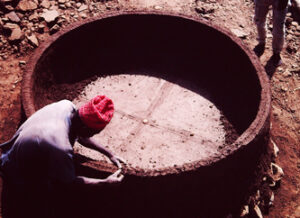
Ayomo (Abasitemi Yeri) was building a new grain store. In the middle of the ground, which was still wet, he had inserted the wen stone of his later ancestral shrine.
If the deceased has no sons, he will not receive his own bogluk, because there would be nobody to sacrifice to it. Such a person’s wen stone is, therefore, set into the bogluk of his oldest deceased full brother, whose children are still in the same house. The stone should be so close to the wen stone of the full brother that, for instance, some sacrificed liquid can easily flow onto the neighbouring stone of the childless ancestor. This ensures that the wen of the dead person gets enough nourishment, even if the ancestor has no {162} male descendants of his own. If all the sons of the same wife of a deceased man die without male descendants, their wen stones are not added to that of a half-brother but find their place on the bogluk of their father, to whom sacrifice is also made by the descendants of the half-brothers.
If a house no longer has any male descendants, there is again a danger that the deceased persons will no longer be sacrificed to. However, there is still the possibility of providing them with sacrificial food by transferring the ancestors’ bogluta to another house within as small a common lineage segment as possible. Such a transfer was observed by Schott in Sandema in 1966 and described in his book Aus Leben und Dichtung eines westafrikanischen Bauernvolkes [endnote 16].
A constant and regular rotation of ancestral shrines among all the compounds of a lineage and the economic and social significance of ancestral shrines will be described in subchapter 5.
If there is no longer any possibility of offering sacrifices to the wen of a deceased person through a descendant, the wen can leave the bogluk in order to, as Leander puts it, “increase the number of evil spirits”. It is probably not entirely clear to most Bulsa in which category of evil spirits these wena are counted. An isolated statement that they became ngandoksa could not be corroborated by other information. Leander’s suggestion that these wena may become loose tanggbana – i.e., tanggbana who have not yet settled in a rock, tree, grove, and so on – and do not receive offerings could not be confirmed either. Most informants claim that the fate of a wen that does not receive offerings is uncertain but that it will not become a jadok or tanggbain.
g) Wen-bogluta of the Bulsa in Southern Ghana
The religion of the Bulsa, with its nature deities (tanggbana), its cultic worship of the earth (teng), and its wen-bogluta firmly attached to the ground, is undoubtedly the expression of a sedentary peasant people. Further, long-term absence from the parental compound {163} and all its shrines can lead to disturbances in the cultic life of the emigrant.
As has already been said, the wena of living persons are not in the human body but are bound to a certain wen-bogluk. This bogluk, however, needs constant care from the living person, whom it can influence through illness, misfortune, and so on. Thus, immediate difficulties are to be expected if the holder of the bogluk leaves it for a longer period of time, for instance, to take up a job in the south of Ghana, because no one else can sacrifice to his wen in such a case. Demands of the wen (sacrifices, kauri ornamentation, transformation, and so on) can usually no longer be fulfilled if there is a distance of two to three days’ travel between the wen-bogluk and its owner. However, the latter may try to create a “substitute bogluk” for his own wen and (even rarely) for those of his ancestors, especially if he plans to spend his whole life or at least many years in southern Ghana. Such bogluta are made according to the instructions of a diviner [endnote 17] in the south, and the diviner also suggests what sacrifices are to be offered to them.
After long negotiations, a Bulo from Cape Coast (born in Gbedema), who was about 50 years old, showed me the two bogluta he had made in the south. They were his own and his father’s wen-bogluk.
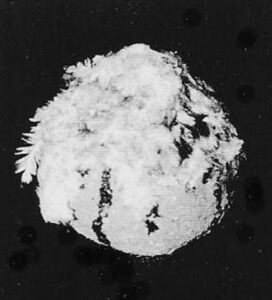
Mobile bogluk (Cape Coast)
The proprietor of the shrine resided in an incomplete building that its constructor had abandoned, owing to financial issues. The only room with a ceiling was his bedroom, where next to the bed, hidden among boxes, buckets, and junk, the young man finally found two bogluta standing loose on the ground. Together with some bones of sacrificed dogs and sheep that were supposed to be on the bogluta, he put them in my hand. Both shrines showed fresh traces of blood and chicken feathers stuck to the wen stone with blood. The personal wen-bogluk was about the same size as its ground-mounted counterparts in northern Ghana. However, the father’s bogluk was only a trifle larger than that of the personal wen – i.e., much smaller than the bogluta of deceased people in the north. Bogluta of deceased people are never placed in front of the house in southern Ghana {164}.
The young man in Cape Coast had no plans to return to Gbedema at the time of my visit. However, if this happened, he would take the animal bones and the stones of the two bogluta and keep them in a safe place in his northern residence. Sacrifices would, however, only be offered to the original bogluta, which were formed from earth in Bulsaland.
Another Bulo (no. 30 of the genealogical survey on p. {183}), who lived as a policeman in a one-room duty flat at the Cape Coast Central Police Station, kept two wen-bogluta with fresh sacrificial traces under his bed. The shrines were almost spherical and had only a narrow base (cf. Fig. 1). The stones of these bogluta and the earth came from Cape Coast. The policeman used to sacrifice here to the wen of his father and grandfather (FF). From his personal bogluk in Sandema, he had only brought the bangle that he sacrificed to and also wore at times in Cape Coast. However, as he felt that such a bangle did not go well with a police uniform, he wore a finger ring as a substitute, which, like the bangle, consisted of three twisted metal wires of different colours.
It should be noted here that the duplication of a wen-bogluk has always been possible in Bulsa society, even without modern influences. In some parts of the Bulsa country, when sons build their own compound after the death of their father, each son can place a wen-bogluk of his father in front of his compound. He takes some earth from the original bogluk, and a diviner adds earth and a new wen stone from his own new plot to make a new wen-bogluk. Only the eldest son sacrifices to his father’s original bogluk, while all the other sons sacrifice to the replicas.
I could not find any confirmation about Bulsa taking their personal wen-bogluk from the north to the south or loosening the stone and surrounding it with earth in the south. The above-mentioned man from Gbedema, who was about 50 years old, even affirmed that such a procedure was quite impossible.
Female wen-bogluta in the south are not known to my Bulsa informants {165}.
h) Function and meaning of the wen-piirika rites and the personal wen
Wen rites are a very important part of the religious system of the Bulsa. They are a prerequisite for functioning and sustainable ancestor veneration over generations because only those who have received a wen-bogluk during their lifetime can become ancestors after their wen has been transferred to a large ancestral shrine in front of the compound (see above: tu-poak laka).
In the religion of the Bulsa, the tintueta-wen occupies an intermediary position between the individual owner and the almighty, eternal sky God (Naawen). The latter is not directly accessible for sacrifices and people’s requests but must be contacted through natural intermediaries. The tintueta-wen is a part of the almighty God and can be asked for help directly by its earthly owner.
In the still quite small sample of 11 documented wen-piirika rites, it may have been noticed that among the causes triggering ritual action, mental confusion plays a great role. In the rite, the sick person becomes the centre of attention in the compound community for a whole day and feels that everyone wants to help him. His contacts with his own tintueta-wen give him the opportunity to communicate his personal problems to a partner and develop a personal relationship with a supernatural power. He can make offerings of supplication and thanksgiving without instructions from his father or the compound head, although he usually informs these people. By laying his hands on the stone or pouring clear water over the bogluk (both of which awaken the wen), he can present purely personal requests, for instance, before an important exam at school, in cases of conflicts with friends or classmates, or even when he wants to court a young girl.
Weakness of character (e.g., quarrelsomeness) or individual evil deeds (e.g., killing chickens with a catapult) is given a very unusual interpretation and reaction. They are neither punished nor forgiven, but the perpetrator is stripped of all moral responsibility. The wen of the person is responsible for his evil behaviour, who wants to enforce his worship in a shrine by creating problems.
By rubbing the body with the white chicken, any evil that is the cause of the wen-piirika passes from the human being into the chicken, which hereby assumes the function of the scapegoat in the Old Testament (cf. Azundem 2020). Even if this transfer is regarded as a deception from the modern scientific point of view, the “placebo” effect remains – i.e., the recipient believes he has received an effective remedy for his problems.
The question remains: how do the ritual actors react to an ineffective wen-piirika – i.e., what should they do if the problems remain or worsen? With the help of a diviner, further measures are decided. Should the whole ritual be repeated because a mistake was made? Does the tintueta-wen require certain sacrifices, a certain accessory (kauris, an iron ring, and so on), or a second bogluk, or does the persistent or renewed trouble come from a completely different supernatural being (e.g., a juik) demanding a shrine?
3. WEN RITES OF FEMALE PERSONS {165}
a) Female wen-bogluta
The construction of a wen-bogluk for girls is carried out in a way similar to the construction for boys, except that ritual acts, such as knocking with the rattle, recitations, and so on, are repeated four times (female principle) rather than three times (male principle).
However, it is very rare for young, unmarried girls to already have their own bogluk. This only happens if they stand out due to extremely unusual behaviour or cause an extraordinary number of problems. According to Leander, these are often girls who have a tanggbain as a guardian spirit (segi). However, by no means do all tanggbain girls have their own wen-bogluk.
The bogluk of an unmarried girl is detached and destroyed after marriage. If necessary, the newly married woman can get a new wen-bogluk at her husband’s house. All the ceremonies for the erection of such a bogluk are then performed again. However, there is isolated information (e.g., Godfrey and Leander) that in some parts of the Bulsa, country girls do not destroy their wen-bogluk after marriag; they rather take it with them whole to their husband’s house.
Normally, a woman gets her first bogluk in her husband’s house. Of Leander’s four wives, for instance, none had a bogluk before she married Leander, while today, they all have their own bogluk. Of Leander’s three daughters, nobody has a bogluk; however, almost all the sons sacrifice to their tintueta-wen.
Girls or women may maintain wen-bogluta – i.e., they may coat them with a new layer of clay if they are weathered or even decorate them with ornaments, but they must never sacrifice to them in the sense of pouring a libation over the stone or killing a sacrificial animal. However, they are to be present at all sacrifices to their own wen. For the unmarried girl, the father sacrifices and for the married woman, the husband {166}.
If a married woman leaves her husband, she will usually detach her wen-bogluk from the ground, destroy it in a secret place, and get rid of the remains so that her former husband cannot use it for harmful spells [endnote 18]. If the woman returns to her parents’ house, she cannot get a new wen-bogluk there, because a woman once married can only possess a bogluk in her husband’s house. If a divorced woman marries another man, however, he can provide her with a new bogluk.
Fig.: Leander formed a new shrine from the crushed clay of the old bogluk. His wife Atigsidum poured water from a calabash (1st ed., Fig. 36).
b) Transformation and adornment of a female wen-bogluk
The wishes of a female wen-bogluk for ornamental objects (rings and cowries) or for reshaping are respected to the same extent as those of male bogluta.
On 5 January 1974, I was able to participate in the transformation of a female bogluk at Leander’s house. Leander’s first wife Atigsidum had been complaining of stomach pains for a long time, and in addition, her otherwise good relationship with the other wives’ children was disturbed. The diviner found that her wen wanted a reshaping of his bogluk, and as an ornament or “crowning glory” (as Leander put it), her wen claimed four cowries. Since Atigsidum had managed Leander’s household with great skill and was partly responsible for the prosperity and well-being of his large family, her wen had proved to be very strong.
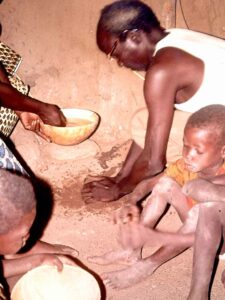
Leander forms a new shrine from the crushed clay of the old one. Atigsidum adds water.
Early one morning, Leander, Atigsidum, and almost [endnote 19] all the children of Leander’s four wives moved to Asik Yeri, their traditional compound in Badomsa. Here, Ayomo Atiim, in the presence of Leander and Atigsidum, offered millet water to the two female ancestors Abandemlie and Aguutalie in the kpilima-dok and to Leander’s biological mother [endnote 20] in front of the house. Afterwards, Leander, Atigsidum, and all the children went into the kpilima-dok, where, against the back wall, Atigsidum’s bogluk stood. Leander and Atigsidum squatted right next to the bogluk. After offering the bogluk some millet water, everyone present drank the rest. Leander crushed the bogluk with a stone, and his wife added clear water from a calabash. He kneaded a ball out of the loamy paste, put it back on the ground at exactly the same place as the old one, and shaped the sides to form a hemispherical mound. The old stone was given its place again in the middle of the clay ball. Then, Leander pressed the four cowries he had bought at the market in a cross shape around the stone, and the following picture emerged in the top view:
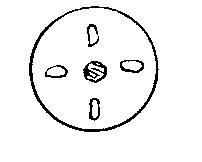
Atigsidum’s wen-bogluk with cowries
Since the cowries are also the eyes of the shrine, it now has more of a chance to keep an eye on the affairs of Atigsidum’s extended family. Leander offered millet water once more, and the rest was drunk by those present. The next sacrifice was a medium-sized brown chicken, whose blood flowed over the stone. The chicken fluttered up and died on one side, which meant that Atigsidum’s wen had accepted the sacrifice. A guinea fowl was killed and its blood offered. Guinea fowls are never used for the oracle of fluttering up.
After this, there was a break of about five hours, during which the women of the house prepared TZ and the two fowls. Late in the afternoon, Leander, Atigsidum, and a few children went back to the kpilima-dok, and Leander offered water, the meat of the hen and guinea fowl, and TZ to Atigsidum’s wen by placing the food on the new bogluk. Then, millet water was sacrificed again. The remaining meat and the prepared millet porridge were eaten in the inner courtyard by all those present; some neighbours had also appeared in the meantime. A piece of meat was placed in the now empty kpilima-dok, where the souls (chiisa) of three deceased ancestors, for whom no funeral had yet been held, were located by their sleeping mats (cf. site plan, chapter, p. 182, nos. 42–44).
This concluded the ritual acts of the day. Leander told me that he hoped that harmony would now be restored in his house and that Atigsidum would consider all of Leander’s children as her own.
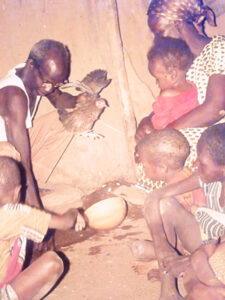
Leander offered the new bogluk with the four cowreis a dark chicken. Almost all of Leander’s children and his wife (right) were present in the kpilima-dok.
c) Construction of a female wen-bogluk (ma-wen) in front of the compound
After the death of a married woman or her husband, no more offerings can be made to a woman’s earthen wen-bogluk [endnote 21]. Only after the funeral of the woman and her husband can the surviving sons of their mother erect a bogluk again. This time, however, it is no longer erected as a small mound of clay but in the form of two stones on the right-hand side of the path leading from the husband’s house to the deceased wife’s parental home (cf. Fig. 43).
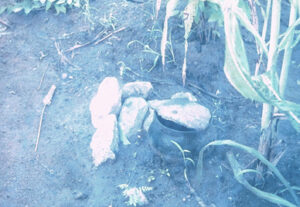
Ma-wen of Adeween Yeri
According to Apatanyin (Sandema-Kalijiisa-Yongsa), this should be done early in the morning, preferably at sunrise. According to unconfirmed information, all the “nephews” (i.e., matrilineal male relatives) of the woman are invited to this new erection of the female shrine, similar to the “outdooring” of a male tintueta-wen-bogluk, and each has a chicken or guinea fowl sacrificed to the new shrine. A sheep or goat is sacrificed by the compound head.
At the latest, the old clay bogluk can be destroyed, and the stone no longer has any significance, as the wen has passed into the new bogluk. Once the latter is chosen as a guardian spirit during a naming ceremony, he receives a naming pot (tibiik), which, from this time on, remains in many compounds of Wiaga with the three stones. Her eldest son sacrifices to the new bogluk, which is called ma-wen-bogluk (bogluk of the mother’s wen). The office of the sacrificer is inherited in the male line. Only when all the woman’s male descendants have died can the bogluk be transferred to the house of one of her daughters, where the husband or son of her daughter sacrifices to it.
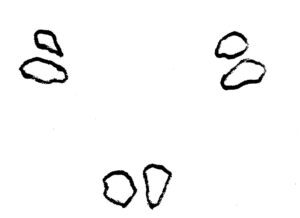
Ma-wena in front of Adeween Yeri (top view)
For example, when Leander’s mother’s mother in Sinyansa-Bachinsa had no male patrilineal descendants left to sacrifice to her bogluk, Leander fetched the bogluk in the form of two stones to his house and placed it next to his own mother’s bogluk. This ritual is again reminiscent of the execution (tu-poak laka) of a male tintueta-wen in front of the compound, for here too all the matrilineal relatives (“nephews”) appear with a chicken to be sacrificed to the new shrine.
{169} Through this transfer, it is possible that the wen of Leander’s grandmother (MM) gets its share of all the offerings that Leander makes to his mother’s wen. The bogluk of three stones (ma-wen) will never take the form of a ma-bage (cf. p. 183 ff.) in the same house because, as will be demonstrated below, these two bogluta of the same person are always in different houses. After the transfer of the ma-bage, the ma-wen is destroyed or left to itself without further sacrifice.
d) Rituals of ma-bage transfers
On 16 August 1973, I was able to attend the transfer of a ma-bage from Leander’s house to the house of the Fumbisi chief. Long before the appointed day, negotiations had taken place between the two groups. The chief of Gbedema also had to be asked for permission because the daughter of the woman whose ma-bage was to be transferred had lived in his house as a wife. The transfer had to be planned particularly carefully because some years ago, when Leander’s older brother Atiim was still yeri-nyono, the same transfer had already been carried out. However, it turned out to be premature because the mother of the Fumbisi chief, who was still alive at that time, did not get along with the ancestor’s mother. The chief’s mother died shortly after the arrival of the ma-bage, while the ma-bage’s wen returned to Badomsa. Therefore, the transfer had to be repeated with all its rituals.
On the day before the festival (15 August), the Fumbisi chief’s nephew Agiisimi, accompanied by the chief’s sister, two sons, and another woman, appeared at Leander’s house. The group brought a large pot of pito, a ram, three chickens, and a guinea fowl. The chief’s sister had already commissioned a puuk pot [endnote 22] with a lid (cf. Fig. 42) from a potter some time before. With this puuk pot (Leander also called it a scabies pot), encased in two calabashes, the sister came to Badomsa at a very early hour in the morning with the other companions on little-used footpaths. She was not allowed to speak a word the whole way; otherwise, all {170} the planned ritual acts were to be repeated on another day. However, as soon as she arrived at Leander’s house and the puuk pot was taken to a safe place, she was allowed to talk to other people again.
Early in the morning of 16 August, guests arrived from all over the country, and even the elders of Badomsa were represented. Only some of Leander’s close relatives, who also lived in the neighbourhood, kept the festive group waiting until 4.00 p.m. so that the realisation would be questioned. As I learned later, there was a dispute among Leander’s relatives, and for this reason, some of them refused to attend a feast together with their opponents. Only after Leander visited them in their compound were they persuaded to come. After their arrival, a long discussion ensued about who had to greet whom first. The greetings took place in groups (Leander’s house, the neighbour’s compound, the Fumbisi group, and so on), with each group having to greet the others.
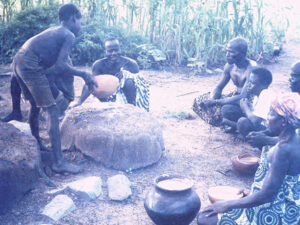
During Ayomo’s offering to Asik’s bogluk, all participants assumed a squatting prayer posture. In the front on the right (next to the pot of millet beer) is the Fumbisi Chief’s sister.
Finally, Leander and Ayomo Atiim squatted down before Asik’s and Adeween’s bogluta, and Ayomo offered millet water to the ancestors, the rest of which was drunk by him and Leander. Then, Ayomo killed a dark chicken with the traditional iron knife (gebik) and let the blood run onto the stones of the two bogluta and Asik’s naming pot (tibiik). He plucked out some soft feathers from the chicken and glued them with blood to the wen stones. Now, the chicken fluttered up and, after some time, died on one side. Leander confessed to me later that he had strong heart palpitations at that moment, because after all difficulties had been removed, he did not want to see the whole daily routine called into question because of the wrong dying position of the chicken. Next, pito was offered to the two bogluta, and the rest in the large clay pot made rounds throughout the festive assembly. I, as a stranger, was also offered a drink. While the chicken was roasted on the open fire by some children, Ayomo, Leander, the Fumbisi chief’s sister, and a few other people moved into the house, where Ayomo offered millet water and then pito to the ma-baga (pl. of ma-bage) of Abandemlie and Aguutalie [endnote 23]. They moved back to the front of the compound, and Ayomo placed roasted chicken meat as an offering on Asik’s {171} and Adeween’s bogluta, the rest of the chicken was consumed by those present.
Then, they prepared to leave Asik Yeri. Some children caught a dark chicken, which was given to the Fumbisi people alive for sacrifice (at home). The chief’s sister had taken the two calabashes containing an empty puuk pot from their hiding place and was now carrying them on her head. She stood apart from the group, and her face was turned away from the party, for from now until her arrival in Fumbisi, she was again not allowed to speak a word.
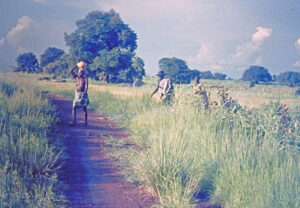
The group moving towards Pung Muning
On narrow footpaths, the company moved to Pung Muning (Red Rock), the tanggbain of Sinyansa-Badomsa, about two km from Leander’s house. At a spot on the foot of the hill where Adeween Yeri, the ancestral compound, had once stood, the turf was removed with a hoe, revealing earth in a circular patch (about 1 m in diameter).
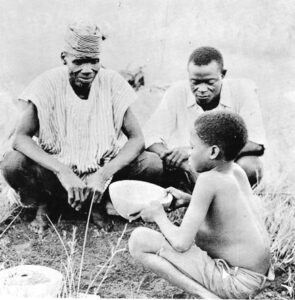
Under the supervision of Leander Amoak, Ayomo offered millet water to the site from which earth was taken. In the front left, the puuk pot in a calabash bowl.
At this spot, Ayomo offered first millet water and then a chicken and a guinea fowl, letting the millet water and the blood of the chickens flow into the loose earth. Two men slaughtered the sheep that the Fumbisi people had brought, whose blood was collected from the carotid artery in a calabash. The last drops of blood were allowed to flow onto the mentioned spot of earth. Finally, Ayomo sacrificed pito, and the rest was served in calabashes to those present. The chickens were immediately roasted, and the sheep was skinned. Some of Leander’s neighbours emptied the sheep’s stomach and intestines, cut up the meat, and put it all into the skinned sheep’s bellows. Only a small part of the ram was already distributed here. I, for instance, had already been allotted a small piece of raw meat.
During all this time, the calabashes with the empty puuk pot stood open next to the place of sacrifice. Next, Leander stuffed earth, damp from the sacrificed millet water, blood, and pito into the small hole of the puuk pot. When it was full, it was closed with a small lid. In the meantime, the two chickens had been roasted and were eaten by those present. Then, Leander placed the puuk pot in the larger calabash, gave them a firmer hold with three sticks, and closed the larger calabash with the smaller {172} one.
The farewells and mutual thanks followed. The Fumbisi chief’s sister could only answer all questions and requests with “Hmmm” (which means yes). The Fumbisi people left after sunset, with the chief’s sister carrying the puuk pot in the two calabashes on her head. The group walked all night to cover the approximately 25-km distance to Fumbisi.
The next morning, Leander carried out the division of the remaining sheep meat with a traditional curved knife in his Badomsa house. No one but him was allowed to touch the meat beforehand – let alone divide it. Lungs, thighs, heart, stomach, and ribs were divided exactly into two. One part was given to the teng-nyono of Sinyansa-Badomsa, the sacrificer to the Pung Muning tanggbain, and the other part was for Leander himself. Part of the intestines was divided into three. The third part was for Leander’s close relatives (e.g., Atiim’s family).
After a few days, Leander (accompanied by me) paid an official visit to the Fumbisi chief. He inquired whether the group had returned home happy. (It had rained the whole night.) The chief did not want to show me the storage place of the ma-bage, as the whole affair was still too “fresh”. However, the puuk pot is probably in a dok (kpilima dok?) today and will also receive part of the offerings during ritual acts.
Next to the puuk pot, there was sometimes a horn (bage) of the ram that was sacrificed at the ma-bage ceremony. Usually, it contains earth as well. According to Anagunsa (Sandema-Yongsa), this horn is always sacrificed together with the ma-bage. However, it is neither worn nor should it be sacrificed to on the same day as male ancestors. Female wen shrines are very dangerous. Anagunsa, who had willingly given me information about his male ancestors, refused to say anything about his female ancestors, because otherwise he “could not sleep at night”.
It is doubtful whether the female bogluk received its name (ma-bage) because of this horn mentioned above, as some informants claim, for the clay pot with contents is called ma-bage, not the horn [endnote 24] {173}.
The houses of Leander and the Fumbisi chief have not only strengthened their friendly relations through the ma-bage transfer but also reaffirmed their kinship. No inhabitant of one house or participant in the ritual (not even the European ethnologist) may now marry a woman from the other house; visible evidence of the kinship relations in the female line is the ma-bage {175}.
PARTICIPANTS IN THE MA-BAGE RITES AT ADEWEEN YERI
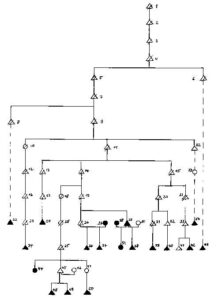
2. Names of the genealogy (participants in italics)
1. Awiag (the original ancestor of Wiaga)
2. Asinyanga (the original ancestor of Sinyansa)
3. Adorang
4. Abadoming (the original ancestor of Badomsa)
5. Awuling
6. Abadomgbana
7. Achang
8. Ayok
9. Ayarik
10. ?
11. Agbana
12. from Wiaga-Farinsa
12a. Atengvuuk
13. Ayueboa
14. Adeween
15. Asanduok
16. Atoalinsi (Siniensi)
17. Ataninanya
18. ? (woman married to the Gbedema chief)
19. Asik
20. Akankisi
21. ?
22. Yeri-nyono of Abaapik Yeri (the kpagi of Badomsa)
23 Awaasiboa
24. Apiung
25. ?
26 Atiim
27. Achinpore
28. Atigsidum
29. Leander Amoak
30 Afulanpok
31 Ataba
32 Abagduok
33. Akasilik
34. Akanming
35. Late Fumbisi Chief Azankoba
36. Ayomo
37. Ayongbiik
38. Akapami
39. Akiak
40. Apiining
41. Achang Akasilik
42. Asaaluk
43. Aniung Aneok (matrilineally related to Leander)
44. Akachaanlie (carried ma-bage)
45 Akanko (Akangamko), the Fumbisi chief who fell ill
46. ?
47. ?
48. Akpanjok
49. Achonsanab
50. Agisimi
51. Akanyaba
52. Azuera
53. ?
54. Ayomo Ayuali (representing Azuera’s descendant living in Kumasi).
{176}
The genealogical overviews will clarify the kinship relationship between the house that took the ma-bage (here, the compound of the Fumbisi chief) and the house from which it was taken (here, Adeween Yeri in Badomsa).
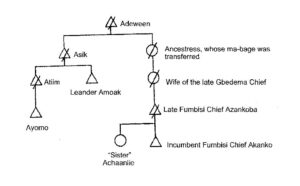
For a better understanding, it is necessary to know that the (living) Fumbisi chief only let himself be replaced by his nephew Agisimi because of a sudden illness. The chief actually wanted to take his great-grandmother’s ma-bage from her parents’ house into his house. This great-grandmother (FMM) was the chief’s father’s mother. This peculiar mixture of patrilineality and matrilineality generally applies to the transfer of a ma-bage [endnote 25]. Although I was told that the living Fumbisi chief only performed the rites of passage in place of his deceased father – and in this case, there is a pure matrilineal connection with the ancestress – by no means could the deceased chief have performed the passage himself during his lifetime, because he was “still too closely related to the deceased” (Leander).
Thus, as a scheme for the transfer of a ma-bage, one obtains the following:
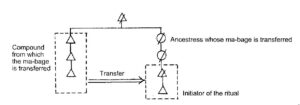
{177} It is irrelevant for the transfer how many generations in the male line have lived in the former parental home of the great-grandmother (FMM) in the meantime.
If the ma-bage is taken from a woman whose wen is worshipped in a three-stone bogluk (ma-wen), then after the transfer of the ma-bage, the ma-wen-bogluk is taken down or left by itself without further sacrifices made to it, for the wen of the woman is only in the ma-bage after the transfer.
As previously mentioned, Asik Yeri’s kpilima-dok also has numerous (5) ma-baga on its own. They had come from various parts of the Bulsa area, transported by the patrilineal members of the compound.
In the following diagrams, the kinship between the ancestress whose ma-bage was transferred and the initiator of the transfer will be illustrated once again in five examples.
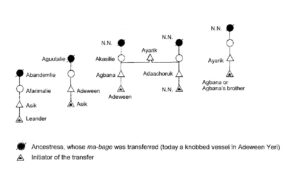
{177}
{178} The individual genealogical sketches listed above can be summarised as follows. Here, the numbers in brackets refer to the genealogical overview (p. 179) and to the site plan of Adeween Yeri (p. 182).
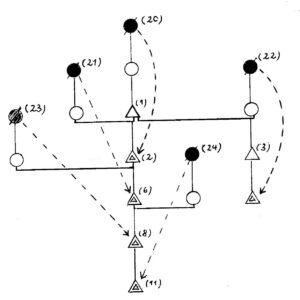
If an informant is asked about the meaning and purpose of the transfer of a ma-bage, one usually receives the answer that through these rites, another important ancestral spirit is incorporated into the household community, and it can help the people gain prosperity, health, and happiness.
When Godfrey told me that these ceremonies possibly just renew marriage prohibitions, which are frequently abandoned in the female line after two to three generations since the relationship of the MM or the MMM is occasionally not widely known to a young marriage candidate, I was a little taken aback.
I would like to agree with his view and regard the ma-bage rites, among other things, as a renewal of kinship relations with the lineages of the women who married into one’s own house, insofar as these can be regarded as ancestors of the currently living inhabitants of the house.
{179}
Another function of the ma-bage shrines, whose earth can be used for a witch’s ordeal (teng nyuka), has already been described above (p. 2, chapter V, 1).
4. WEN SHRINES IN THE COMPOUNDS
ADEWEEN YERI (WIAGA-BADOMSA)
a) Genealogical overview and site-plan {179}
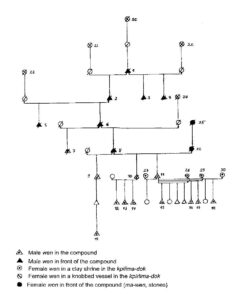
b) Site Plan of Adeween Yeri
Upper left part: Leander’s quarters; lower part: Atiim’s quarters; between them: cattle yard.
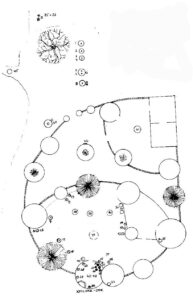
c) Names of the genealogical overview and the site plan of Adeween Yeri {180}
c1) Male wena
1. Ayarik
2. Agbana
3. Adaachoruk [endnote 25a]
4. Atendaang (the brother of Adaachoruk)
5. Ageng
6. Adeween
7. Abonwari
8. Asik
8a. Achesik
9. Akanvuk
9a. Apaadivari
10. Atiim
11. Leander Amoak
12. Michael Abaala
13. Ayomo
14. Ayongbiik
15. J. Anamboro
16, Akapami
17. L. Akanbe
18. Afarinmonsa
19. Atongka
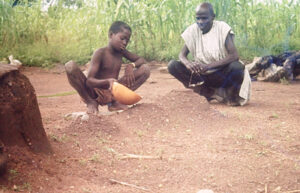
Ayomo and Leander offering to the oldest ancestors of Adeween Yeri
c2) Female wena (ma-baga)
20. ?
21. “Mother of Akasilie”
22. ?
23. Aguutalie (Wiaga-Guuta)
24. Abandemlie (Wiaga-Bandem)
25. Born in Wiaga-Chiok
26. Adankunlie (Wiaga-Bachinsa)
27. Atigsidum (Wiaga-Yisobsa)
28. Adaminyiini (Sandema-Abilyeri)
29. Afulanpok (Wiaga-Yimonsa)
30. Atoalinpok (Wiaga-Farinsa)
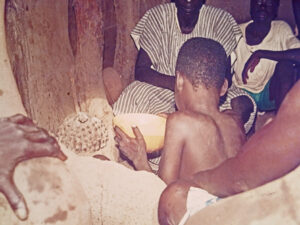
Offering to a ma-bage in the ancestral room
c3) Ngandoksa (see site plan)
31. Jadok waab (Adeween’s divination-bogluk)
32. Bunoruk (chameleon relief on the granary)
33. Jadok yuk (yuk is a monitor lizard and a clay pot with a lid on the roof of the house; the associated branched fork with horns and calabashes is in the kpilima-dok.)
34. A stone inherited from the ancestors but whose meaning is no longer known (receives sacrifices), which comes from a tanggbain near Kadema
35. Jadok on the roof of the house, a white and round stone {181}
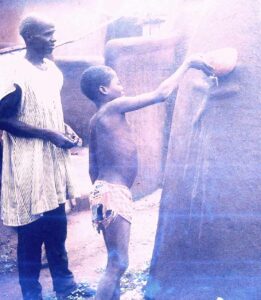
Offering to the relief of a chameleon jadok shrine on the central grain store (List no. 32)
Fig.: Offering to the relief of a chameleon jadok shrine on the central grain store (List no. 32)
c4) Tiim-bogluk
36. Nipok-tiim: Two pots and one stone with an iron ring (The branched fork with various items is in the kpilima-dok.)
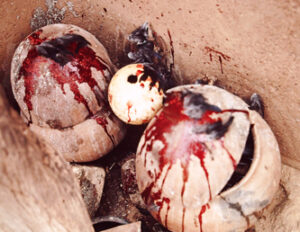
The nipok-tiim shrine of Adeween Yeri. It is usually in the ancestral room, but is placed in the inner courtyard for sacrifices.
c5) Teng
37. The horn (teng) filled with earth of a teng or tanggbbain is usually in the kpilima-dok, but it receives sacrifices in the middle or the main courtyard.
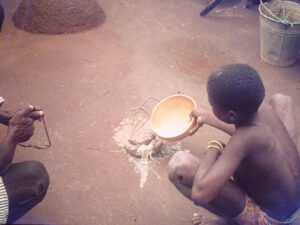
In the middle of the main courtyard, Ayomo made an offering to a teng horn
c6) Graves
38 Akorum (Asik’s wife)
39 Abonwari (wen: no. 7; tomb without a body; cf. p. 354, note 5).
40. Asik (wen: no. 8)
41 Adankunlie (wen: no. 26)
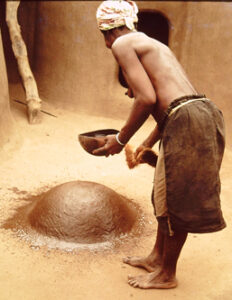
The eldest wife of Adeween Yeri has plastered a grave of one of the ancestors
c7) Chiisa (sleeping mats with the “souls” of deceased people in the kpilima-dok)
42. Abonwari (wen: no. 7; grave: no. 39)
43 Atiim (wen: no. 10)
44. Akanzaliba (the daughter’s son of no. 6) – his mat is in Adeween Yeri, because his family had not taken care of him (in his lifetime). However, his family can claim the funeral celebration for themselves.
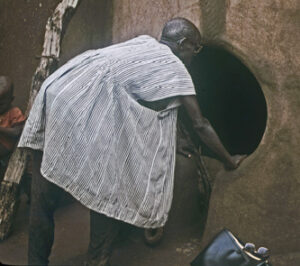
Before a sacrifice, Leander informed the soul (chiik) of the actual compound head Abonwari, which stayed in his death mat.
c8) Others
45. The place where earth was dug for Akapami’s wen-bogluk (cf. p. 148 ff.) {184}
AMOANUNG YERI (SANDEMA-KALIJIISA-YONGSA)
a) Genealogy {183}
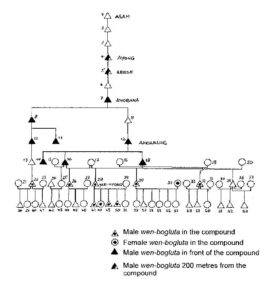
b) Names of the genealogical overview and the site-plan (Amoanung Yeri)
1. Asam (the original ancestor of Sandema and brother of Awiag; cf. genealogical overview, p. 174, no. 1).
2. Agoluk
3. Asajik
4. Ayong (the original ancestor of Yongsa)
5. Abese
6 Afetuik
7. Amobana
8. Ajiak
9. Asiadi
10 Anyaribe
11 Ayomo
12. Amoanung (the builder of Amoanung Yeri)
13. Ateng
14. Akajoluk
15. Akonlie
16. Awarikaro
17. Akamaboro
18. Awaabil
19. ?
20. Anyalape
21. Achimalia
22. Angang
23. Asinieng
24. Abalansa
25. Atankunlie
26. Adocta
27. Azonglie
28. Apatanyin
29. Abamagsimi
30. Abenab
31. Asagi
32. Abankunlie
33. Akankpewen
34. Apogma
35. Afenab
36. (A woman from Siniensi)
37. Asiensalie
38. Kofi
39. Afua
40. Talata
41. Still without a name
42. Baba
43. Comfort
44. Alice
45. Timothy
46. Mary
47. Azangbiok
48. Awatie
49. Martin Assibi
50. Kwabena
51. Angawomi
52. Assibilie
53. Kwabena
54. Lariba
55. Aguare
56. Talata
57. Achipagrik
58. Aghana
59. Anamoanung (Amuning)
60. Akuruma
61. ?
62. ?
63. Adocta (in Siniensi)
c) Site plans of Amoanung Yeri {185}
Bogluta of living persons in the inner courtyard of the yeri-nyono (site plan)
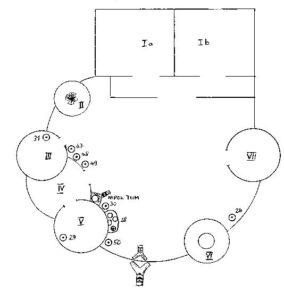
I Rectangular house with zinc roof
1a Sleeping room of (26), 27, 44-46
1b Sleeping room of (47), 49, 50, 53
II Grainstore (bui)
III Kitchen and sleeping room (?) of (30, 31, 52, 54-57)
IV Dalong: Sleeping room in the rainy season of 28, 29, 51
V Dayiik: sleeping room in very cold nights of 28, 29, 51
VI Grinding room (nanzuk)
VII Kitchen
(The numbers in brackets refer to inhabitants of the compound, who were, at the time of my census, in Southern Ghana)
Ancestral shrines in front of Amoanung Yeri (around the kusung) {186}
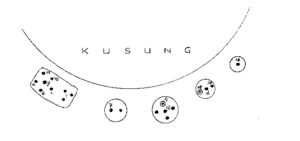
Note:
a, b and c: other sons of 8 (names not known), d: brother of 14 and 16
The small black dotes are meant to represent the wen-stones
The wen-stones of 9 and 18 have an iron bangle
ANYENANGDU YERI (BADOMSA)
People, their bogluta, and other sacred objects and places
a) Census of Anyenangdu Yeri, 1997
Note: The present genealogical census of Anyenangdu Yeri includes those living in the compound during my stays, those who have migrated to southern Ghana and are expected to return, and deceased people who are significant for the social structure of the compound, whose shrines or graves are still in the compound, or who have been mentioned in the present work. Women who have left their husbands in Anyenangdu Yeri and daughters who have married have only been included if they have children in the compound or if their daughters and children have some relevance to the compound or to this work for other reasons.
If I knew the literal translation of the name, I added it in brackets. (The suffix -lie here is always translated as “daughter” but can also be understood as a suffix for determining gender.) All birth figures without months have been estimated. (If the estimate is very uncertain, an “approx.” appears before the year.)
Word explanations
Segi: This is the guardian spirit (e.g., ancestor or earth spirit) of a living person to whom that person was dedicated at the naming ceremony (segrika). On this occasion, the person concerned received a goat’s horn (bage) filled with earth from the shrine in question.
Tanggbain horn (bage): This is a goat horn filled with earth from the earth shrine (tanggbain) Pung Muning and given to a person for protective purposes.
Wen, tintueta-wen-bogluk: This is the personal shrine of a living person in the form of a mound of clay about 10 cm high in the residential quarter (see 14.2.1, p. 804).
Jadok: This is a clay sculpture of the jadok animal next to the personal wen shrine (see 14.2.3, p. 806).
Juik: This is the Mungo shrine of a living person in the compound (see 14.2.5, p. 807 f.).
Abbreviations: * born, † died, ∞ married to, f. female, m. male, NN a name not known
underlined capitals: Anamogsi’s wives (AGBIERA),
bold: Anamogsi’s sons and daughters (Akanpaabadai)
– Anamogsi’s grandchildren (- Angmanya)
ANAMOGSI’S ANCESTORS
ABADOMGBANA (gbana means “skins”; the father’s name [Abadoming] has been placed here in abbreviated form before the proper name), son of Abadoming, founder of Badomsa (whose shrine stands in Amieruk Yeri, Badomsa), and father of Abagomsi: Abadomgbana’s ancestral shrine stands in front of Anyenangdu Yeri (photo 2; genealogy: Fig. 2.57, p. 139, and Fig. 2.58, p. 140).
ABAGOMSI, son of Abadomgbana and father of Atiim, both ancestral shrines are in front of the compound
ATIIM (medicine), son of Abagomsi and father of Asueri, whose ancestral shrines are in front of the compound
ASUERI, son of Atiim and father of Aluechari; Asueri’s ancestral shrine is in front of the compound
ALUECHARI, son of Asueri and father of Anyenangdu; Aluechari’s, ancestral shrine (photo 133) is in front of the compound: His sacred horn segi-bage with earth from Asueri’s ancestral shrine is in the dalong; segi: Asueri; another (secondary) ancestral shrine of Aluechari is in Atinang Yeri.
ANYENANGDU, compound founder of Anyenangdu Yeri; *between 1885 and 1894 (he was three years old when his parental compound was attacked by the slave raider Babatu); 1973 (grave in quarter E); segi: Asueri; wen and jadok (waa-kpieng) in Agbiera’s courtyard; two sacral horns: tinangsa-bage and segi-bage in dalong? his first funeral: 3–6 March 1991; his mother: Amogaang from Wiaga-Wabilinsa; his father: Aluechari
∞ 1. Awenlie, Anamogsi’s mother from Wiaga-Yisobsa: Her ancestral shrine (ma-wen) is in front of the compound, and her grave is near the outer compound wall.
∞ 2. Akamba: She lived in Wiaga-Farinsa in 1997 and was invited to Anyenangdu’s funeral ceremony in 1991 (did not appear).
∞ 3. N.N., buried near Anyenangdu Yeri
ANAMOGSI’S FAMILY (mainly in Anyenangdu Yeri)
ANAMOGSI Awomanyoro (photos 16, 133, and 177), son of Anyenangdu and Awenlie (see above) and acting compound head since 1973; *approx. 1925; two wena; jadok shrines: chameleon, shea butter tree, and turtle?; tanggbain horn; juik: He is the teng-nyono (earth priest) of the Pung Muning tanggbain (earth shrine), kpagi (elder) of all descendants of Abadomgbana (see above), and tiim-nyono (healer, with a famous birth-medicine; he also treats kikiruk births).
∞ AGBIERA (photo 22); *approx. 1930 in Wiaga-Bachinsa; married before 1957; wen and jadok (bunoruk) in her bedroom
Akanyigseba; f.; died shortly after Anyenangdu (1973); an unmarried woman: Her funeral service was held with that of Anyenangdu in 1991.
Akanpaabadai (“does not reach the day”; photos 133 and 147); m.; *before 1957 (he was 10 months old when the compound was established); two wena; two ngandoksa (bunorta and waa-kpieng); tanggbain horn; juik (photo 176)
∞ Ajimi; before 1984; she left the compound between 1984 and 1986
– Angmanya (“to take away [and] see”); m.; *ca. 1982; segi: Awenlie (Anamogsi’s mother): Angmanya lived in the compound (1997).
∞ Ajadoklie (photo 36); *ca. 1960 in Fumbisi-Kasiesa; wen and tanggbain horn; potter
– Amaaboro (“help and live”); m.; *1982; no wen
– Azakopo ; m.; *1983; segi: Aluechari; wen and tanggbain-horn
– Akanchainlie; f.; *1985; segi: Aluechari; not in compound in the years 1994 and 1997
– Akanchainfiik; f.; no wen; *1988; † 13 December 1988 (pneumonia; grave in tampoi; burial documented)
– Boy *? December 1990, 1990, or 1991: He died when he was four weeks old.
– Ayaakanapo (“love with the mouth”) juik (“Mungo”); m.; *June 1994: He is mute (deaf and mute?).
– Amiliani; f.; *8 February 1998
∞ Abas(I) (“abandoned”); *1965 in Gbedema: She was with her parents in Gbedema in 1994 (there was a juik in her bedroom after her return) and in 1997 in the compound.
– Apaaribil; *1987; segi: Pung Muning; tanggbain horn; † before 1994
– Son; *May 1994; 1995 (unnamed)
– Son (photo 176); *end of 1996 or 1997: He was still nameless in 1997 but already wearing a juik skin.
∞ Akanjaglie (“daughter of Kanjaga”; photos 141 and 181); *1965 in Kanjaga-Jiningsa; her doglie 1997: Adaamkwota (“a quarter of millet beer”), Kanjaga-Jiningsa
– Abaangmami (“they rebuke me”) or Akanjodum; m.; *1987; segi: Agbana
– Ajuikbil (“little mongoose”); m.; *1990; segi: juik; wen; tanggbain-horn
– Awencharuk (“God’s share”); m.; *1993
∞ Asuemlie (“daughter of a hare”; photo 4); *1973 in Kanjaga-Jiningsa; doglie and full sister of Akanjaglie; no wen; Asuemlie’s doglie 1994: Akpangkadi (“close to”); in 1997 no longer in the compound
– Ajowiepo (“to enter into trouble”); f.; *1991
– Laadifiik; f.; *1994; no Buli name in 1997; juik
– Ajuipok; f.; twin; *15 November 1997;
– Ajuilie; f.; twin; *15 November 1997; segrika on 10 January 1998: juik
Abuntalie (“daughter of a stone” – i.e., “daughter of tanggbain Pung Muning”); f.; married to Wiaga-Longsa; segi: tanggbain Pung Muning
Akabaasim (“no health”); f.; married to Wiaga-Kubelinsa (has a daughter)
Apagratoa (“is strong and brave”); f.; married to Wiaga-Longsa
Asimi (“against me”); m.; *1973; segi: Aluechari; wen; moved out before 1994 (housekeeper in Takoradi)
∞ (January 1994) Wife from Wiaga-Mutuensa, who left him before 1997
∞ NN (Anamogsi’s wife)
Ababy; m.; died nameless aged one and a half years: He was the first male grandson of Anyenangdu; therefore he received the funeral ceremony of an adult (in connection with Anyenangdu) in 1991.
∞ ACHIOKLIE (“daughter of Chiok”); *ca. 1930 in Wiaga-Chiok; wen; tanggbain-horn; one boosuk-snake-jadok
Assibi (“Saturday”); f.; ∞ to Sandema (living there)
– Awensaglie (“God-teaching daughter”) Martha; f.; 1994 and 1997 in Anyenangdu Yeri; Abuluk Primary School; P6 (1997)
Aka(a)yabisa (“does not love children”; photo 153); m.; *before 1957; segi: ma-bage of Atiim’s mother; wen; tanggbain-horn; juik
∞ (1983) Abachoba (“they urge her [to quarrel]”) or Abachinsalie (Bachinsa’s daughter) from Wiaga-Bachinsa; left Anyenangdu Yeri approx. 1985
– Lamisi; m.; Anamogsi’s first grandson – therefore, he has an adult grave at the compound wall
∞ Awunlie (“daughter of God”); *ca. 1961 in Wiaga-Kubelinsa; tanggbain horn
– Anmoatibanyaka (“not close [enough] to see it”; photo 167]; m.; *1984; wen
– Ajopai; f.; *1986; segi: Aluechari
– Akisiyong (“another taboo”); m.; *1989; 24 January 1989; poi nyatika (pregnancy ritual)
– Talata (“Tuesday”); f.; *1993
– Twins; *15 November 1997
∞ Achiiklie (“daughter of the moon”); *1970 in Wiaga-Mutuensa; wen; after 1993 (?) she had been for some years in the south; 1997 back in the compound
– Alakpingsi; m.; *1990 (1994 in compound)
– Girl (still nameless in 1997); *1995 or 1996
∞ Awiinya (“call and see”); *1965 in Wiaga-Yisobsa; school education; married in 1989 or 1990
∞ Kenkenni (“the younger one”); *1978 in Sandema-Bilinsa
– Akanligmi (“don’t lock me up”); m.; *beginning of 1995
– Girl; *1996 (still nameless in 1997)
Angmeentemi (“don’t force me”); f.; ∞ in Kokofu (Ashanti)
Aparik (“wall”; photos 58, 59, and 156); m.; *1974; wen; jadok (bunorta); segi: tanggbain Pung Muning; bage-horn (?) since 1994 in Kumasi
∞ AKUMLIE (“daughter of death”); *ca. 1930 in Siniensi-Zungdem; wen; jadok (bunorta); tanggbain-horn
Asuebisa (“fill with children” or “children of Asueri”); m.; *1955 (eldest living son of Anamogsi); segi: Asueri; wen; jadok (bunorta; photo 172); tanggbain-horn
∞ Akanyaaminyaka (“do not wish my sight”) or (in short form) Akaaminyaka (photo 21); *1960 in Wiaga-Bachinsa; wen; tanggbain-horn
– Ajokpilung (“entering the realm of the dead”); m.; *1981; segi: tanggbain Pung Muning; wen
– Akansang (“does not persecute”); m.; *1984; segi: Asueri; †26 February 1996 from measles and (preceding?) cholera; buried in the cattle yard
– Aka(n)yaayega (“does not love much”); m.; *1987; segi: Aluechari; wen
– Maami (Engl.); f.; *1990; surviving twin (boy: Paapa; died shortly after birth); no Buli name in 1997
– Sunday; *24 July 1994; no Buli name in 1997
∞ Asakpawie (“matter of the witch”; two siblings died before her by witchcraft) or Ayaakaalie; *1965 in Sandema-Pungsa; wen shrine destroyed before she left Anyenangdu Yeri around 1990 (not returned in 1997)
– Anbiaba (“did not give birth to her”); m.; 1997 in Anyenangdu Yeri; segi: Aluechari
– Alimsi (“wait”); f.; *1986
– Assibi (“Saturday”); f.; *1991
∞ Azekadi (“didn’t know it was like that”); *1965 in Sandema-Nyansa; married before 1984; left Anyenangdu Yeri before 1986
Awenyiini (“only God”; short form Anyiini; photos 37 and 39); f.; *approx. 1963; sega: Aluechari and tanggbain Pung Muning; with one sacral horn (bage) each. Because of supernatural powers she is considered the female yeri-nyono of Anyenangdu Yeri; potter
Abawomba (“they listen to them”); m.; *1969; in 1994 with wife and children in southern Ghana (garden boy in Accra); jadok (bunorta; photo 172), wen
∞ Mary; *1970 in Sandema-Yongsa
– Akajaalie (“have-not-daughter”); f.; *1987; segi: Aluechari
– Asiateba (“agrees with them”); m.; *between 1990 and 1993
Aleeti (“late”) Abangdisapo (“when forgotten?”; photos 16, 34, 37, 153, and 156); m.; *1978; segi: Aluechari; wen (photo 172)
∞10 October 1997 Talata from Akannyavari Yeri, Wiaga-Sichaasa
Akanbolukum (“is not at death”; photo 16); m.; *1972; segi: tanggbain Pung Muning; wen (photo 172)
Lamisi (“Thursday”; photo 37); f.; *1979; segi: Aluechari; 1997: Abuluk Junior Secondary School, Form 2
Awalingkame (“really try”); f.; *1960; often returns to her parental home
∞ to Kadema
∞ to Farinsa
– Akaasidi (“spoils it”); m.; *1978: He has been in the compound since early childhood.
∞ to Tankansa
– Akanmeapoti; f.; *1987; not in compound, wears two iron moons around her neck.
Atalebabe (“where [will he] leave her?”); f.; ∞ to Uwasi (has a daughter, 1989 in Anyenangdu)
AYABALIE sen. (“daughter of the market”), from Wiaga-Zuedema, left Anyenangdu Yeri long ago to marry a man from Gbedema (2 children), thereafter a man from Sandema-Bilinsa, where she lived in 1997.
Adaanlie (“daughter of the millet beer”); lives in Sandema
∞ man from Sandema
– Akok (“ghost”); m.; lives in Sandema
– Girl; lives in Sandema
– Yaw (“Thursday”; Twi); m.; visits Anyenangdu Yeri often; permanent residence in Sandema
– Janet; f.; Form 2 of Sandema Secondary School (boarding school) in 1997; lived in Anyenangdu Yeri in 1997 during holidays
Aka(ba)wai (“have none of them”; photo 46); f.; *1955; wen, Anamogsi’ eldest daughter
∞ Akumasi; from Apok Yeri (Yisobsa, currently in Southern Ghana)
– Yaw (“Thursday”; Twi) Williams Emmanuel Akumjogbe Akumasi (“Where does death fail?”); m; *1973 (1994–1998 in Anyenangdu Yeri); later in Southern Ghana
∞ Jelia Asimbisalie (“daughter of Fumbisi”) in 1994 from Fumbisi
Adungkalie (“daughter of the animal”); f.; *15 October 1997 (no segrika yet in 1999)
– Kwaku (“Wednesday”; Twi) Agbiak; m.; in southern Ghana
– Diana Lamisi (“Thursday”) Asiuklie (“daughter of the road”); f.; *1981; potter; St. Martin’s Junior Secondary School, Form 2
– Kofi (“Friday”; Twi); m.; *1984 (no Buli name; no segrika; no wen); school only up to P3
– Atamangbe (“where to hide [from witches]”); m.; *1988
– Akudomlie (“it pains daughter”) Rosemon; f.; *1990
∞ ASIUKPIENLIE (“daughter of the big road”; photos 21 and 34); *ca. 1950 in Gbedema-Jaksa-Dabomsa; wen; jadok (bunorta); tanggbain horn
Anyebokatoa (“making life is hard”); short form Atoa (photos 17, 47, and 177); m.; *1970; segi: tanggbain Pung Muning; wen; wuri-jadok (two monitor lizards); juik (photo 175)
∞ Apuyiilalie (“stop thinking, daughter”); *1970 in Wiaga-Wabilinsa; wen
– Amugribadek (“deceive yourself”); m.; *September 1990
— Twins; *11 January 1998
∞ Ayomalie (“daughter of a slave”); *1977 in Fumbisi-Kasiesa; wen; jadok (bunorta)
– Anamboro (“suffer and live”); m.; *1993?
– Akannurubawie (“not a man’s problems”); m.; *1993?
Akanmaami (“does not help me”; photo 184); short form Amaami; m.; *1973; segi: tanggbain Pung Muning; wen; jadok (bunorta); left compound before 1994 (for Koforidua)
Achiviepo (“in shame”); m.; *1976; segi: tanggbain Pung Muning; wen; jadok bunorta; tanggbain horn; left in 1995 (works in cocoa plantations in Bibiani)
Akumjaab (“being of death”; photos 5 and 34); f.; *1984; segi: tanggbain Pung Muning; 1994 in Southern Ghana; 1997 in the compound
Adeboalie (“what to eat, daughter”); f.; *1986; segi: Aluechari
∞ AKANKONURBA (“not kill people”) Siniensi-Zungdem; doglie of Akumlie; wen; tanggbain-horn; juik
Awen(le)biisi (“God speaks”); short form Abiisi (photos 47 and 184); m.; *1969; segi: tanggbain Pung Muning; wen; moved to Nangoodi near Bolgatanga (a gold mine) in 1994; returned in 1997
∞ Yaa Ababorokadila; 1990; leaves him; no children; in 1997, Abiisi not married
Awentemi (“God gave me”; photo 156); m.; *1963; segi: Asueri’s mother; wen; left the compound in 1995 (to work in a cocoa plantation near Bibiani); in Anyenangdu Yeri in 1997
Laadi; f.; *1975; student; baptised Catholic on 17 July 1994; wen; moved out in 1995 (maid servant in Kumasi); 1997 Anyenangdu Yeri; St. Martin’s Junior Secondary School Wiaga, Form 2 (1997)
Adiilie (“daughter of doubt”); f.; *1977; segi: Anamogsi’s mother Awenlie; wen; Abuluk Primary School Wiaga, P2 (1997)
Atengkabiik (“child of the Earth”); m.; *1981; segi: Anamogsi’s mother Awenlie; wen
Apagrimka (“strength is missing”; photo 167); m.; *1985; wen; in 1997 Abuluk Primary School (Wiaga-Sinyansa)
Atani (“Monday”); f; *1987; wen
∞ AGOALIE (“daughter of the bush”); *ca. 1930 in Sandema-Nyansa; wen; jadok (bunoruk); tanggbain horn; one daughter (Pauline) from a previous marriage; was the author’s cook in 1988 or 1989, 1994, and 1997; doglieba: Azuma and Ayabalie jun. (see below)
∞ ABATUILIE; *ca.1940 in Fumbisi-Kasiesa-Batiensa; tanggbain horn; in the compound in 1986, which she left again; returned on 23 September 1988; not in the compound in 1994 and 1997
∞ MAAMI; *1968 in Sandema-Longsa; left the compound in ca. 1985; Akankonurba’s doglie
Asiakdila (“agree with”); f.; *1982; lives in Akankonurba’s quarters
Atigilie (“daughter of the tigi festival”; photo 171); f.; *1985; lives in Akankonurba’s quarters
∞ AZUMA (“Friday”; photo 139); *1970 in Sandema-Kobdem; wen; tanggbain horn; jadok (bunoruk); doglie of Agoalie; Azuma’s doglie in 1994: Anaamalie (no longer in the compound in 1997); Azuma’s doglie in 1997: Atindaanlie (from Sandema-Kobdem)
Agoabe (“where do I sleep?”); m.; *1987; segi: tanggbain Pung Muning; wen; 1997: Abuluk Primary School Wiaga-Sinyansa, P3
Akpibengeba (“die, stay [cut] and leave them”); f.; *July or August 1990;
Anyediki (“to make quiet”); short form Adiki or Asiki; f.; *1993; †1 November 1998
∞ AYABALIE jun. (“daughter of the market”; photo 139); * 1959 in Sandema-Nyansa; wen; tanggbain horn; juik; doglie of Agoalie; Ayabalie had doglie Afaalie in 1989 who left Anyenangdu Yeri before 1994
Abenibadek (“stay with yourself”; photo 168); f.; *1986; segi: tanggbain Pung Muning; wen; not in Anyenangdu Yeri in 1994 and 1997 (waa doglie somewhere)
Ababeniba (“they dwell on themselves”; here, “they waste their time”); f.; *1988; segrika: 17 September 1988: tanggbain Pung Muning; † between 1989 and 1994
Anako (“strike and kill”) Kwame (“Saturday”; Twi); m.; *1990; segi: Anyenangdu; wen
Anyasiokbe (“where can I find a brother?”); m.; *5 July 1994
∞ AKANNYEANYIN (“cannot do and leave”); doglie of Ayabalie; married Anamogsi between 1989 and 1994; then moved out; the wen was still in Anyenangdu Yeri in 1997
Anyamlie; f.; in 1994 not in Anyenangdu Yeri
∞ AYOMPOK (“wife of a slave”); *1975 in Fumbisi-Kasiesa; was the doglie of Abatuilie: She already had a wen shrine in Fumbisi and received a new one in Anyenangdu Yeri.
Anyetebanya (“do it so they see”), Agbambil, or Agbong (“flat roof”); m.; *1993; segi: tanggbain Pung Muning; tanggbain horn; wen
Atogsawana; m.; *1995; tanggbain horn
∞ AKANZABWAI (“despises no one”); f.; *1978 in Wiaga-Chiok; doglie of Achioklie; f.;
girl *14 January 1999; still without a name (later name: Assibi)
In 1997, Abajaasalie (called Ajaanlie), the aged daughter of Abasitemi, also lived in Anyenangdu Yeri. She had moved out of Abasitemi Yeri (incumbent yeri-nyono Ayomo Ayuali) in 1995 and had been taken in by Anamogsi. On 27 March 1995, she was initiated as a diviner in the jadok-gobika ritual. However, it was later discovered that a mistake had been made in this; therefore, the initiation had to be repeated.
b) Compound plan of Anyenangdu Yeri 1994 (with shrines)
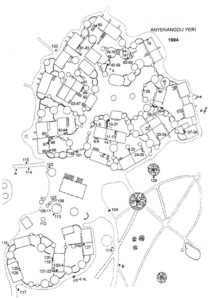
c) Names of the shrines in Anyenangdu Yeri (cf. map)
1. Tintueta-wen: Awentemi (Akankonurba’s son)
2. Tintueta-wen: Adiilie (Akankonurba’s daughter)
3. Tintueta-wen: Laadi (Akankonurba’s daughter)
4. Tintueta-wen: Awenbiisi (Akankonurba’s son)
5. Tintueta-wen: Its owner is a child no longer living in the compound.
6. Tintueta-wen: Apagrimka (Akankonurba’s son)
7. Tintueta-wen: Atani (Akankonurba’s daughter)
8. Tintueta-wen: Atengkabiik (Akankonurba’s son)
9. Tintueta-wen: Akankonurba (Anamogsi’s wife) – the wen owned a bangle in 1986 that was no longer in its place in 1994.
10. Hanging on the inner wall of the room was Akankonurba’s juik (mongoose shrine) with a calabash bowl and a purple waist cord.
11. Tintueta-wen: Akumlie (Anamogsi’s wife)
12. Tibiik: Akumlie’s wen medicine in a ceramic vessel
13. Bunoruk-jadok: Akumlie’s chameleon shrine
14. Hanging on the wall was Akumlie’s juik with a dawadawa pod and a purple waist string.
15. Tintueta-wen: Asuebisa (Akumlie’s eldest son)
16. Bunorta-ngandoksa: Asuebisa’s shrine of two chameleons
17. Tintueta-wen: Abawomba (Akumlie’s son)
18. Bunorta-ngandoksa: Abawomba’s two chameleon shrines
19. Tintueta-wen: Akanbolukum (Akumlie’s son)
20. Tintueta-wen: Aleeti (Akumlie’s son)
21. Tintueta-wen: Ajokpilung (Akaaminyaka’s son)
22. On the wall was a bage – Aleeti’s horn with soil from Aluechari’s ancestral shrine.
23. Tintueta-wen: Aka(n)yaayega (Akaaminyaka’s son)
24. Tintueta-wen: Akaaminyaka (Asuebisa’s wife)
25. Tibiik: Akaaminyaka’s wen medicine was in a clay jar with an extract from the roots of the diniensidi tree, a remedy for twin births. (She had previously given birth to twins; see no. 63).
26. Tintueta-wen: Atoa (Asiukpienlie’s son)
27. Wuri-ngandoksa: Atoa’s two monitor shrines
28. Tintueta-wen: Akanmaami (Asiukpienlie’s son)
29. Bunorta-ngandoksa: Akanmaami’s two chameleon shrines
30. An elongated bogluk (?)
31. Tintueta-wen: Achiviepo (Asiukpienlie’s son)
32. Bunorta-ngandoksa: Achiviepo’s two chameleon shrines
33. Tintueta-wen: Apuyiilalie (Atoa’s wife)
34. Tibiik: Apuyiilalie’s wen medicine was in a ceramic knobbed pot.
35. Tintueta-wen: Asiukpienlie (Anamogsi’s wife)
36. Bunorta-ngandoksa: Asiukplienlie’s two chameleon shrines
37. Tintueta-wen: Ayomalie (Atoa’s second wife)
38. Bunorta-ngandoksa: Ayomalie’s two chameleon shrines
39. Tintueta-wen: Anyetebanya (Ayompok’s son)
40. Tintueta-wen: Ayompok (Anamogsi’s wife)
41. Tiim-bang: Anamogsi’s bracelet was for magical purposes (receives sacrifice).
42. Tintueta-wen: Asimi (Agbiera’s son)
43 and 44 Tintueta-wena: Two personal shrines of Akanpaabadai (Anamogsi’s son)
45. Tibiik: Akanpaabadai’s wen medicine was in a cheng vessel.
46. Waab-jadok: Akanpaabadai’s snake-jadok (waa-kpieng; “python”)
47. Bunorta-ngandoksa (on the wall of a grain store): two chameleon shrines of Akanpaabadai
48. Bage (on the wall of the grain store): Akanpaabadai’s horn with earth from Pung Muning
49. Jubiik: animal tail (belonged to Akanpaabadai’s wen)
50. Tintueta-wen: Angmanya
51 and 52 Tintueta-wena: two personal wen shrines of Anamogsi
53. Teng-bage: Anamogsi’s horn with soil from the tanggbain Pung Muning; belonged to his wen shrine
54. Tinangsa: a loose bundle of medicine roots belonging to Anamogsi’s wen shrine
55. Tibiik: Anamogsi’s wen medicine
56. Bunoruk-jadok: Anamogsi’s chameleon shrine
57. Jadok: Anamogsi’s (clay) jadok with a small turtle shell
58. Cham-jadok: Anamogsi’s shea butter tree shrine with one small plant with root and soil in a PVC bag
59. Tibiik: another medicine of Anamogsi in a ceramic vessel
60. Tintueta-wen: Anyenangdu (Anamogsi’s deceased father)
61. Wen-tibiik: Anyenangdu’s wen medicine in a knobbed ceramic pot
62. Wa-kpieng-tonga(-jadok): Anyenangdu’s snake-jadok, above which on a nail (on the dalong wall) were two iron bangles and a string with a piece of snakeskin
63. Biam-tiim (birth medicine) or kikiruk-tiim (medicine against kikita and malevolent twins): large clay vessel with pieces of root and a root extract of the diniensidi tree (see also Fig. 14.11, p. 817)
64. Anamogsi’s juik with waist string, millet cob, calabash shell, and dawadawa pod
65. Bunorta-ngandoksa of Anamogsi’s mother Awenlie: two clay reliefs on the floor
66. Nipong-tiim shrine: ceramic kampiuk vessel with medicine on a clay pedestal – on the wall was a baobab bowl with nipok-biaroba-tiim (birth medicine for women), which probably belongs to the nipong-tiim.
67. Anyenangdu’s tinangsa-bage: animal horn with medicine
68. Anyenangdu’s segi-bage: naming horn with earth from Aluechari’s wen shrine
69. Aluechari’s segi-bage: naming horn with earth from Asueri’s wen shrine
70. Yom-tiim: medicine added to the widows’ bath on the second day of the juka funeral
71. Ma-bage (knobbed pot): Anyenangdu’s mother Amogaang or Anyenangdu’s MM
72. Ma-bage (knobbed pot): Aluechari’s mother and MM
73. Ma-bage (knobbed pot): Asueri’s mother or MM
74. Ma-bage (knobbed pot): Atiim’s mother or MM (the vessel is on the flat roof of the dalong)
75. Nipok-tiim: In 1994, only a few shards and a branched fork of this tibiik vessel were left; the medicine is supposed to prevent married women from running away.
76. Tintueta-wen: Agbiera (Anamogsi’s first wife)
77. Tibiik with takabi (shard): ceramic vessel with wen medicine (of Agbiera)
78. Bunorta-ngandoksa: Agbiera’s two chameleon shrines
79. Place for Akanpaabadai’s juik, which is currently in Asuemlie’s bedroom, as her youngest daughter Laadifiik, who is a few weeks old, was just awarded a juik (place of sacrifice: shrine 117)
80. Tintueta-wen with a twisted iron ring: Ajadoklie (Akanpaabadai’s wife)
81. Tintueta-wen: Awencharuk (Akanjaglie’s son)
82. Tintueta-wen: Ajuikbil (Akanjaglie’s son)
83. Tintueta-wen: Achioklie (Anamogsi’s wife)
84. Teng-bage: Achioklie’s horn with soil from the Pung Muning tanggbain – it belongs to her wen.
85. Tibiik: Achioklie’s wen medicine
86. Boosuk-jadok: Achioklie’s viper shrine in the form of a clay relief
87. Juik of Achioklie’s jadok
88. Tintueta-wen: Akayabisa (Achioklie’s eldest son)
89. Tintueta-wen: Aparik (Achioklie’s son)
90. Bunorta-ngandoksa: Aparik’s two chameleon shrines
91. Tintueta-wen: Anmoatibanyaka (Awunlie and Akayabisa’s son)
92. Tintueta-wen with an iron bracelet on the wall: Agoalie (Anamogsi’s wife)
93. Tinangsa: three bundles of loose medicinal roots; belong to Agoalie’s wen (see also Fig. 14.9, p. 837)
94. Bunoruk-jadok: Agoalie’s chameleon shrine
95. Tintueta-wen: Akawai (Anamogsi’s daughter who has returned to her father’s compound)
96. Tintueta-wen with four cowries and an iron ring: Ayabalie (Anamogsi’s wife)
97. Hanging on the wall was Ayabalie’s juik with one small calabash bowl, one millet cob, one pepper pod, and one purple waist string
98. Tintueta-wen with two cowries: Abenibadek (Ayabalie’s daughter)
99. Tintueta-wen: Anako (Ayabalie’s son)
100. Tintueta-wen – non-stationary cement bogluk: Akannyeanying (Anamogsi’s divorced wife)
101. Teng-bogluk: stone from the tanggbain Pung Muning in a branched fork (“watchman”)
102. Ma-wen (ancestral shrine) of Anamogsi’s mother Awenlie
103. Ma-wen (ancestral shrine) of Abadomgbana’s mother
104. Ma-wen (ancestral shrine) of Abagomsi’s mother
104a. Ma-wen of Asueri’s mother (from Siniensi)
105. Tibiok-tanggbain: sacrificial stone under a baobab (here, a tibiok – i.e., “evil tree”)
106. Wen (ancestral shrine): Aluechari (Anyenangdu’s father)
107. Wen (ancestral shrine): Asueri
108. Wen (ancestral shrine): Atiim
109. Wen (ancestral shrine): Ayarik
110. Wen (ancestral shrine): Anyam
111. Wen (ancestral shrine): Abagomsi
112. Wen (ancestral shrine): Abadomgbana
113. Behind the kusung-dok is a tengkuk (earth shrine), a stone collected in the neighbourhood of the compound
114. Sacrificial site (stone) of Akankonurba’s juik (at first, Anamogsi sacrificed, and when Akankonurba’s son Abiisi was old enough, he took over the sacrificial activity.)
115. Sacrificial site (stone) of Akumlie’s juik (Her son Asuebisa sacrifices.)
116. Sacrificial site (stone) of Anamogsi’s juik
117. Sacrificial site (stone) of Ayabalie’s juik
118. Sacrificial site (stone) of Akanpaabadai’s juik
119. Tintueta-wen: Agoabe (Azuma’s son)
120. Tintueta-wen: Akpibengeba (Azuma’s daughter)
121. Tintueta-wen: Azuma (Anamogsi’s wife)
122. Bunoruk-jadok: Azuma’s chameleon shrine
123. Teng-bage: Azuma’s horn with soil from the tanggbain Pung Muning
124. Teng-bage: Agoabe’s horn with soil from the tanggbain Pung Muning
125. Teng-bage (horn) belonging to Ayompok
126. Teng-bage (horn) belonging to Ayompok’s son Anyetebanya
127. Tintueta-wen: Achiiklie (Akayabisa’s wife)
128. Not on the site plan: Pung Muning earth sanctuary (tanggbain) (approx. 500 m west of the compound)
The juik shrines of Akayabisa (Achioklie’s son) and Atoa (Asiukpienlie’s son) were erected after the 1994 “inventory”:
A: Stone: Akayabisa’s juik
B: Stone: Atoa’s juik
d) Graves in Anyenangdu Yeri
a) Anyenangdu’s grave
b) Grave of Anyenangdu’s mother Amogaang
c) Grave of Anamogsi’s mother Awenlie
d) Grave of another wife of Anyenangdu
e) Grave of Lamisi, the first grandson of Anamogsi (son of Akayabisa and his wife Abachoba, who no longer lived in the compound)
5. SOCIO-ECONOMIC SIGNIFICANCE OF OWNING ANCESTRAL SHRINES
The religious significance of ancestor veneration has already been pointed out several times. However, ancestor veneration, in connection with the male ancestor shrines in front of the compound, has also economic and social significance, as I have explained in my publications of 1982 and 2003.
The possession of a male ancestor’s shrine is linked to precisely defined further property claims. The sacrificer, which usually means the compound head, has also taken over all the ancestor’s land and livestock with the shrine. Ancestral land usually makes up, by far, the largest part of a compound’s landholding. In addition, the sacrificer (compound head) is the head (kpagi) of all the descendants of the ancestor concerned.
If this shrine owner dies, the male descendant of the ancestor with the greatest seniority succeeds and inherits the shrine – i.e., the oldest living male descendant of the oldest generation becomes the new sacrificer and thus the new owner of the ancestral land and ancestral cattle (including their descendants), and at the same time, he becomes the new kpagi. If this descendant, for instance, is the next oldest brother of the deceased and lives in the same compound, the locations of the ancestral shrines do not change. However, if he lives in another compound, the ancestors (more precisely, the wen stones) are transferred to the compound of the successor, where a similar shrine is erected for them with a new clay base and the old stones. With this, the ancestral land and ancestral cattle (in earlier times, also the slaves or their descendants) become the property of the new sacrificer.
If a lineage consists of about 50 compounds, as is the case in Wiaga-Badomsa, the shrine owner changes with each predecessor’s death. Thus, it is possible for the shrine with attached land and livestock to rotate through all 50 compounds of the lineage. A poor compound can become the richest compound in the lineage in a relatively short time. By assuming the kpagi title, the sacrificer gains prestige, power, and in many ways, the authority to give instructions to others.
The assumption and acquisition of shrines, property, and prestige is not quite as unexpected as it may first appear. Even very young men know exactly when they can take over a high office and possession of land etc., and who in their lineage or lineage segment is entitled to it before them (see genealogy with the marking of the past or future taking over of the shrine in Kröger 1982: 56).
It should only be briefly pointed out here how important the knowledge of this change of ownership according to the seniority principle is for planning agricultural development projects in Bulsaland.
6. CONFLICTS OF CHRISTIAN STUDENTS WITH THEIR FATHERS {187}
A few years after starting school, most Bulsa boys and girls become Christians. By this time, many boys already have their personal wen-bogluk [endnote 26]. On the one hand, while the White Fathers in Wiaga regard animal sacrifice as an outdated (Old Testament) but by no means blasphemous act of sacrifice, many Catholic teachers and the missionaries of the Presbyterian Church demand a complete renunciation of all pagan customs and sacrifices from the new convert [endnote 26a].
On the other hand, I was always amazed at how little resistance the traditional religion presented to the new Christian doctrine. It is true that no father wants his son to become a Christian, but the decision of the son or daughter is almost always respected. One rather gets the impression that the more aggressive part is the younger Christian generation. My young informant from Wiaga Kubelinsa (cf. p. 154) was not content to stop sacrificing after his baptism but reproached his father that they would all still give up their faith in the old gods and come to the church. To this, the father could only reply that he (the son) had to blame himself for all the consequences of his behaviour. The fear of the immediate consequences of a certain ritual behaviour seems to play a greater role than ideological considerations.
The following excerpt from Ayarik’s life story (Wiaga Tandem-Zuedema) probably shows typical features of the conflict situation indicated above in the boy’s unwillingness to compromise and the grandfather’s helplessness:
When I went home from my parents to my grandfather, he offered me a god [bogluk], and this god was always in front of my room, and I was sacrificing it, but when I went to school, it came to a time that we were doing our religious studies, and our teacher told us that anyone of us who had a god should destroy it and be attending church, because it was {188} meaningless to kill fowls for a stone. That evening when I reached home, I took my god and threw it away during the absence of my grandfather, but when my grandfather noticed it, he asked me, and I told him I had destroyed it, but he put it back again [endnote 27] and asked me to kill a goat for it, and I refused. From this time on he asked my brother to do it for me, and when my brother did it, I knew that I was still the one, and so I destroyed it again and again. He asked me why, and I told him I was ready to do all such things, because I wanted to become a Catholic, and so my grandfather kept cool and never brought the god back to me again up to today. And so at present I am a Catholic altogether with my family, and I don’t think I shall ever kill a fowl for a stone any more, nor will any of my children.
Other fathers already seem to know that sons usually give up their old faith when they go to school, as described by a young secondary school graduate from Siniensi in his life story:
So in class 4 [primary school] I told my father that I wanted [to] go to Church and leave the sacrificing. He allowed me, because he knew that once someone is in school he does not sacrifice.
When older Christians sometimes rebuild their personal wen-bogluk, it is not always at the insistence of the father. If you ask such a Christian why he has rebuilt his formerly destroyed bogluk and why he is again sacrificing regularly (i.e., at least twice a year) to his wen, you will often get the answer, “I was forced.” What is meant is the coercion not so much by the father but by one’s own wen, whose existence, in my experience, is not denied even by many practising Christians.
An example of coercion by one’s own wen became clear to me in the case of a Christian Bulo in Takoradi (Southern Ghana), who was about thirty years old. He was no longer successful in his occupation, often fell ill, had great financial difficulties, and had to hear constantly from other {189} Bulsa that the reason for all this was that his own wen was making demands for a bogluk. Finally, he went to a diviner himself, who confirmed his friends’ suspicions. On his next visit to his home village of Sandema, he had a new bogluk erected for his wen, to which he had been sacrificing ever since, without abandoning his Christian faith.
In another case, a Christian disciple bowed to the combined urging of his father and his personal wen:
So my father was happy all the time with me, but he became annoyed with me any time that he wanted to make sacrifices. I always refused to help in sacrifices, when he asked me to do something, and [I] told him that I was not to do sacrifices again. I was baptized in 1969 by the Roman Fathers. I was then in Middle School. Six months after my baptism I became very sick of stomach, they tried to cure me but they failed. So one day at dawn in bed I heard some strange man calling my name and saying that I should wake up and get my personal “god”. I did not know what to do. My father said, if the man asked me to do anything, I should do it, otherwise I would die from my sickness. That because of that I was ill. So I got my personal god that day …
A week later I recovered and started my schooling [again]. My father told me not to go to church on Sundays again but I refused. Again I refused to make sacrifices. In a year’s time I became sick again. My father told me that I had been against the house gods, which is why they want to kill me. So I should sacrifice [to] all the house-gods. I did it. Not long [after] I became well. From that time until now I make sacrifices to the Builsa gods [bogluk] and other things.
Typical of the conflict situation dealt with in this section is apparently the father’s concern that his son’s health might suffer through his neglect of the “house gods”. The informant himself also feared, above all, that the neglected wen would punish him in revenge through illness and an early death. For this reason and not out of obedience to his father, he has probably resumed his sacrificial activities [endnote 28] {190}.
7. WEN VENERATION AND SUN CULT
Early researchers of Gur-speaking peoples already noticed that the names for God and sun are identical in many ethnic groups. Occasionally, some often vague statements about an existing or former sun cult can also be found in the early literature. L. G. Binger [endnote 29] wrote about the autochthonous population of the Mossi in 1892:
Ils sont fétichistes, mais ont eu pour culte le soleil, qui porte encore aujourd’hui le même nom que Dieu: ils l’appellent Wouidi.
They are fetishists, but have worshipped the sun, which to this day bears the same name as God: they call it Wouidi.
E. Funke [endnote 30] believes he can recognise two different circles in northern Togo with regard to our question: a north-western circle, in which the words for sun and God belong to the same language group, and a north-eastern circle, in which this is the case with the words for sky and God. In the northwestern circle, which today falls mostly within the national territory of Ghana, he counts the following ethnic groups: Dagarti, Kusasi, Mossi, Mamprusi, Dagomba, Moba, and Konkomba. Funke also believes he has already discovered an effort to “keep the name of God from being identified with the sky or the sun” and that this effort is “increasing more and more from north to south” (Funke, p. 162).
L. Tauxier (1924) [endnote 31] refers to Binger [endnote 32], Desplagnes [endnote 33], and his own works on the question of whether the Mossi worshipped the sun. He believes that Ouendé was probably originally a sun and atmospheric god but that through the influence of Islam, he was eventually worshipped only as the supreme God (p. 33):
C’est ainsi que, peu à peu, Ouendé est devenu de plus en plus un dieu suprême, quoi qu’il semble n’avoir été, au début, qu’un dieu-atmosphère d’abord séparés, puis qui fusionnèrent, avec prédominance de l’élément divinité-soleil.
And so, little by little, Ouendé became more and more a supreme God, although at first he seems to have been nothing more than an atmosphere god, first separate, then merged, with the sun-divinity element predominating.
For R. S. Rattray [endnote 34], it is also certain that the linguistic equivalents for sky god and sun are identical:
In both the Mole and the Kasen’-Isal groups, the word used for the Sky-God is practically identical throughout. (In some of {191} the dialects the word Na or Nab’ (Chief) is prefixed). The root of the word used by all these tribes for the Supreme Being is we. The word undoubtedly means simply ‘the sun’.
Rattray (1969), however, draws attention to the fact that the supreme deity is regarded by men as a sky god but not as a sun god:
(p. 43) Wene is the Sky God not the Sun God. ‘The Sun falls in the evening time, but He is always there’, said an informant, whom I was questioning on this subject.
(p. 308, Nankanse) Yini, himself, is far, and we cannot get him, only some of his power. The sun is the son of Yini.
J. Zwernemann [endnote 35] came to similar conclusions in more recent times (1961). In the section on the Mossi (p. 245), he provides a revealing quotation from the work of R. P. G. Alexandre [endnote 36], from which it emerges that the Mossi usually make a conceptual distinction between the sun (wintoo) in the sky and the god Wende, while in certain sacrificial formulas, the quality of Wende as the “sun god” still shines through:
… que le Roi Soleil reçoive l’eau de la sortie (lever) (l’eau est versée à l’est) … que le Roi Soleil reçoive l’eau des son coucher (on verse l’eau à l’ouest).
… that the Sun King receives the water from the exit (sunrise) (the water is poured in the east) … that the Sun King receives the water from his sunset (the water is poured in the west).
After J. Zwernemann extensively studied the concept of god in several “Volta tribes” (tribus voltaïques), he comes to this conclusion:
L’association terminologique de dieu à ciel ou à soleil est confirmée par nos sources. Dieu demeure au ciel ou dans le soleil… Souvent on indentifie le dieu et le ciel, peut-être on l’identifie même au soleil: le rituel de certains sacrifices mosi nous incite à formuler une telle conclusion [endnote 37].
The terminological association of God with sky or sun is confirmed by our sources. God dwells in the sky or in the sun … The God is often identified with the sky, perhaps even with the sun: the ritual of certain Mosi sacrifices leads us to draw such a conclusion [endnote 37].
For the Bulsa, I have come to the following conclusions on the question discussed here:
1. As has been stated earlier (Rattray, p. 45), the names for god (or heaven, sun, and the power of fate) in many Gur languages can be traced back to the same root, which {192} according to Rattray (p. 42) is we, according to D. Westermann to a Paleo-Sudanic root *qui or *quia [endnote 38]. Without any doubt can the Buli word wen also be linguistically inserted into this group.
2. In the Buli language, the word wen also has several meanings: God (as supreme being mostly in the form Naawen), personal power over the fate of a living or dead person (which can be worshipped in a wen-bogluk), sky, sun, and season.
3. The Bulsa do not equate the terms god and sun in the sense that the sun is referred to as Naawen or that Naawen is regarded as the sun god. Moreover, the term wen is usually applied in word compounds for the visible sun [endnote 38a], which is usually called kantueng, wentueng [endnote 39] (sun, heat of the sun, or the hottest time of the day), or wenbiri (def. wenbini; biri = seed?; “sun disk”).
4. The Bulsa use the term Naawen to designate the highest being, while wen is more often used for the power worshipped in a bogluk. The term Naawen (from nab wen) causes some linguistic difficulties. It is usually translated as king of heaven or chief of heaven. In the composition nab wen, however, nab is an attributive genitive to wen, and its literal translation would be “the wen of the chief” [endnote 40]. As long as the presence of the form na(b)wen cannot be explained otherwise, E. Funke’s interpretation of this name cannot be entirely rejected. He explains the connection of the name of God with the word na, which occurs in several Gur languages, as the result of a foreign influence. About the “western circle” of northern Togo (cf. p. 190), he writes the following [endnote 41]:
The tribes there with a Mohammedan upper class add the word “na” to the word interpreted as “sun-god”, which means “elder, lord” … In this way, one wants to prevent the easily arising, erroneous perception that one is paying homage to a sun or sky worship. Therefore, the Haussa have been copied, which always speak of “Ubangidji Allah” or Allah “Ubangidji” (Lord God) {193}.
If, until now, the derivation of a connection between the highest being and the sun has essentially been attempted on the basis of linguistic criteria, the following ideas will also prove a connection in the cultic sphere. Authors from the early 20th century, in particular, have repeatedly attempted to trace religious manifestations on a worldwide scale back to the original sun worship of primitive peoples. Unfortunately, scientists such as L. Frobenius [endnote 42] and P. Ehrenreich [endnote 43] preferably based their theories on myth interpretations, which can no longer be unreservedly agreed upon today. Since an interpretation of myths can only make sense if at least the basics of the religious beliefs and cults of the ethnic group concerned are known, a contribution to the question of sun worship will be given here, which is based on observations of cultic forms.
Among the Bulsa, a connection between the wen, which is revered as divine, and the visible sun is probably most obvious in the climax of the wen-piirika rites (cf. p. 148, chapter V2a). As already described, the diviner pressed the wen stone exactly halfway into the earth ball when the rising sun emerged exactly halfway “out of the earth”. Even if Bulsa had not given the interpretation that the stone symbolises the sun and the ball of clay symbolises the earth, the attentive observer would notice that a natural event is being reenacted here on a ritual level. In addition, wen stones, especially for larger bogluta, consist of spherical white quartz stones, which can also represent the sun well in their shape and colour.
Extremely important for an understanding of the concept of wen, however, is the informants’ statement that in this ritual act, with the first rays of the sun, the personal wen descends from the sun and from then on has its place in the stone. The wen cannot descend from the sky if the sun’s rays do not directly touch the wen stone – for instance, because there is a cloud cover between the sun and the stone [endnote 44].
While the personal wen, when it was still in the sun, could already exert an influence on the human partner – e.g., plague him with illnesses or cause difficulties through accumulated misfortunes – it is only after the descent of the wen that a close interrelationship between the human being and his wen is possible, since only then can the holder respond to all the wishes of his wen and reveal all his own wishes to the wen.
As already indicated in the description of the wen-piirika, another important highlight of the festival rites is the mixing of human saliva with the earth, and from this, the Buli name tintueta-wen (saliva-wen) for the personal wen is derived. The new bogluk is, thus, created by mixing three elements: the wen, which comes from the sun; materials from the earth (clay, stone, and water); and saliva, which creates a close connection between the holder and the new bogluk.
The establishment of a mental association between “saliva” and “sun” no longer seems to be necessary. However, there are indications among other peoples in Africa that saliva and the sun can have a cultic connection. Some interesting phenomena in other African cultures should, therefore, be pointed out here.
In H. Baumann’s [endnote 45] remarks on African solar cults, one finds a hint that sun worship among some East African peoples can consist of prayers, invocations, and cultic spitting.
H. Fokken writes about the Masai [endnote 46]:
The morning prayer is said by all adults, old men, warriors and women. They rise from their camp and spit some saliva towards the rising sun …
I could not find any corresponding information for West Africa or even for the Gur peoples.
If the wen ceremonies show remnants of a solar cult that may have been more pronounced in earlier times, the question is allowed whether further signs of sun worship can be found in the present-day {195} religious expressions of the Bulsa. Unfortunately, I have only been able to deal with this task to a limited extent during my fieldwork. Therefore, only some hypotheses, questions, and suggestions for further research can be given here. The religious use of language, prayer formulas, and names of gods, among others, should be examined to see whether remnants of a solar cult can be found, even though current religious leaders are no longer aware of a relationship to sun worship [endnote 47].
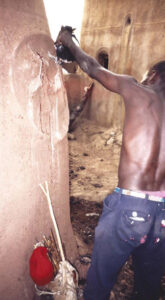
Sacrifice to a chameleon jadok on the surface of a grainstore
Schott [endnote 48] has already pointed out how much reverence and shyness the Bulsa have for the chameleon. While ancestral bogluta always stand on the ground, the bogluta of chameleon-ngandoksa are either 1–2-m high in the form of bas-reliefs on the granaries [endnote 49] or on the clay parapet of a flat roof.
According to Le Heriseé, the chameleon represents the sun among the Eastern Ewe. It was placed in the forest by the “sun god” Lissa to remind the people that he (Lissa) can colour his garment (the evening sky) every evening in a similar way to the chameleon. Regarding this myth, H. Baumann remarks, “Here we have the key to the solar conception of the chameleon [endnote 50] …” In other African groups, too, the chameleon can represent the sun [endnote 51]. However, in the case of the Bulsa, I failed to pursue the question of a reference of the chameleon to the sun.
Finally, the myths of the Bulsa and their neighbouring tribes should be examined for sun motifs. Even if the collection of Bulsa myths and stories has not yet been completed [endnote 52], it can already be said that the yield will not be very large, unless one wants to follow the interpretation of some authors and interpret twin myths, wandering myths, and devouring motifs, among others, purely cosmologically [endnote 53]. The Dagomba myth, handed down by A. W. Cardinall [endnote 54], which states Wuni (cf. Buli wen) owns a circular compound (compound = sun) surrounded by a market (court of the sun), has often been quoted. In the compound lives a ram [endnote 55], which, through various activities {196}, produces thunder, lightning, rain, and wind.
8. CONSIDERATIONS ON THE SHAPES OF THE BOGLUTA
As already mentioned, the stone of a wen-bogluk can be interpreted as the image of the sun, the earthen base is supposed to represent the earth. Leander, who gave me this explanation, immediately added a second one. Sometimes, the Bulsa also refer to the wen stone as the head of the bogluk and the earthen foundation as its body. As already described, two indented cowries may represent the eyes of the wen-bogluk (cf. p. 159). Here, too, interesting investigations could follow. Did the anthropomorphic shrines of other peoples of West Africa perhaps develop from forms that resembled the wen-bogluta of the Bulsa, or are the wen-bogluta abstractions from anthropomorphic representations [endnote 55]? However, going into such questions would go beyond the scope of this work.
According to Rattray [endnote 56], the Nankanse (Gurense) also regard the mounds (Buli: wen-bogluta) as the homes of spirits (p. 325). Rattray writes the following (p. 325):
The actual spirit is in (or ‘is’) the axe, bangle … the conical clay mounds into which such objects are built are regarded rather as the ‘compound’ or ‘quarters’ in which the spirit may wander in greater ease and comfort.
I have never been given such an interpretation of the shapes of Bulsa shrines. The wen-bogluta of the Bulsa also always lack the hole in the lower part of the mound mentioned by Rattray in this context, which is supposed to correspond to the house entrance (cf. also Rattray, p. 216). However, for divination bogluta, whose shapes are more reminiscent of the conical shrines of the Nankanse (Gurensi) described by Rattray and usually have a hole (an “entrance”) in the lower part of the mound, the term ngandoksa dok (house of the ngandoksa), among other designations, is common among the Bulsa. Often, these bogluta are surrounded by small mud walls, 10–20-cm high, which are interpreted as walls of the compound (yeri) and their interruption at the front as the compound as the entrance (Information: Leander) {197}.
Rattray also represents (p. 540) a hypothesis about the origin of the ancestral “bogluta”:
Among the Nabdam and Talense, these flat-topped mounds often mark the actual graves, upon which the sacrifice is made. This indeed, is, I believe, the origin of all these shrines, even where, as in many cases, they are now distinct from the actual burial place.
No evidence for Rattray’s latter hypothesis could be found among the Bulsa {198}.
ENDNOTES
CHAPTER 5: WEN RITES
1. 1960: 187–196
2. J. B. Christensen (1954: 93) writes about a certain “soul” of man, which the Fanti (southern Ghana) call sunsum, “[which] may leave the body at night and roam about, and dreams are said to be activities of the sunsum …” The sunsum soul can also be attacked by witches of sorcerers, according to the Fanti’s view.
3. It must be mentioned that a single informant claims that the soul (chiik) leaves the body only on dreamless nights, while a dream proves that it is in the body.
4. The Buli word kaabi (to sacrifice) is used for the offering of food to the souls of the deceased. It is understood, however, that this is a kind of sacrifice that is different from those offered to the wena, for instance. Chiisa do not receive bloody animal sacrifices; however, they may receive prepared animal food that is never offered to the wena – e.g., cooked duck meat {359}.
4a. Wena can leave their shrine temporarily, for instance, to make contact with other wena. I was also told that, if possible, one should not sacrifice on market days because the wena are then at the market. The wena‘s kinship relations are independent of those of the human owners. The mother of a wen, for instance, can have her own shrine built in the form of another small mound of clay next to the wen shrine. It has no special relationship with the owner’s mother’s shrine. Of the other supernatural powers, only jadoksa can have their own wena.
5. Several realms of the dead for different Bulsa clan sections are mentioned by Schott in his essay “Kisuk Animals of the Bulsa”. Cardinall (1931: 34) names Pilimpico the realm of the dead of Sandema, and a mysterious path is said to lead directly from the marketplace of Sandema to the town of Pilimpico.
5a. Cf. J. Aduedem 2018.
5b. D. Tait writes about the Konkomba (1961: 223f.) that evil bush spirits choose their victims carefully. “It is noteworthy that most persons so attacked are either in adolescence or in young adulthood.”
6. Piirika was translated to me as “coming down of the wen“. The verb piiri seems to be used only in this specific sense; there is supposedly no linguistic relationship to the homophonic verb piiri (to inflate).
In 1986, I received isolated information that in urgent cases, when a wen-piirika has to be postponed, a preliminary wen-piirika can be performed in a very simplified form. It is called wen-dungka.
7. The term bogluk is used to describe all those material sanctuaries or shrines to which offerings are made (the English translation is often “shrine” or “god”). While the term wen (or jadok, tiim, and so on) implies a spiritual principle, bogluk refers to the external form of the object (e.g., a small mound of clay with stone, a filled medicine pot, a rattle, and so on) to which sacrifice is made.
7a. I could not obtain final clarity about the number of stones of a ma-wen. I clearly saw this shrine in the form of one but also two stones. In front of Adeween Yeri, there are three stones, one of which probably has no meaning. Occasionally, I heard that the second stone represents the wen of the MM. This is contradicted by the fact that when all patrilineal male descendants of the owner’s MM in Wiaga-Bachinsa had died, Leander Amoak transferred the shrine in the form of two stones to his own compound.
7b. The soothsayer Akanming usually struck the heads of the ritual subjects with his rattle, sometimes also with his hand, which contained a certain medicine, especially if the issue concerned a mental disorder.
7c. Da-binta is a precipitate from millet beer production that is used as “yeast” for the next production and is, therefore, not a waste product. In later wen-piirika rituals, Akanming used the word da-bu(u)sa, which I had not heard before, for a similar-looking red mass; it was described as a pure waste product and could at most be fed to chickens. Some informants claimed that da-binta and da-bu(u)sa were the same.
8. Tintuek (pl. tintueta; lit. saliva): According to my information, there is no linguistic or contextual connection to tintueta = “ashes”.
9. Unfortunately, I did not have my tape recorder switched on during the procession, so I could only reproduce Leander’s version about whose correctness there are strong doubts. It is possible that the sentence already quoted was repeated; however, there is no evidence for this either. It can be said with certainty that the soothsayer continuously used a “false” name (Akagoom) for Akapami.
9a. The following text was recorded by me on a tape and translated by Godfrey Achaw.
10. I do not think that I failed to include this part. It is much more likely that Leander himself wanted terms such as Naawen (high God), kpilima (ancestors), teng (earth), and tanggbana mentioned in the prayer and included them in an additional part together with the name of his son Akapami.
11. If a chicken dies lying on its belly immediately after the blood has been drained, the sacrifice is considered not accepted, and the rites of the {360} day must be repeated at a later date.
12. Again, the number 3 is meant to symbolise Akapami’s male gender.
12a. A broken baobab bowl (tu-poak) was used instead of a calabash bowl for sacrifice. Even today, the shard of a baobab fruit is used in sacrifices to a ma-bage after the miscarriage of a woman.
12b. cf. Endnote 7a
13. cf. Schott, 1973/74: 285
14. According to R. S. Rattray (1960: 182), among the Nankanse (Gurensi), a bat, which is called a “brown room guinea fowl”, can also be sacrificed to the sky god.
15. Unpublished field notes 1966/67: 189f
15a. Only in front of Ameeruk Yeri in Wiaga-Badomsa did I find iron bolts instead of round stones in the ancestral shrines in front of the homestead. I was told that the ancestors had wanted it that way.
16. pp. 25–28 and Figs. 33–42
17. In many towns in southern Ghana (e.g., Cape Coast), there are no Bulsa diviners. In such a case, the Bulsa look for another diviner from northern Ghana. (They are often mistakenly called Frafra diviners in the south.) An Akan diviner from southern Ghana can never proffer instructions to a Bulo.
18. The same procedure is followed when her husband dies. If the woman remarries after the funeral celebration for the dead, she receives a new bogluk from her new husband, even if her new husband lives in the same compound as her old one.
19. George Awenawie, who attended St. Martin’s Middle School (Wiaga), evaded the offering ceremony.
20. If Leander and Ayomo’s father Atiim were not sons of the same mother (Adankunlie), Leander would have had to offer the sacrifice to Adankunlie himself.
21. cf. Rattray’s (1969: 509) report on the fate of a female bogluk (Isal: dema) among the Isala (1969: 509).
22. A puuk (pl. puusa) is a spherical clay pot with a small lid and many knobs (cf. Fig. 42). It can never be bought on the market but must be commissioned from a potter. Since its production is allegedly not without danger (?), usually only old potters “who do not fear death” (inf. Th. Achaab from Kalijiisa-Choabisa; 1973–1974; resident in Fumbisi) are willing to make such a pot. The name pùùk (spoken with a low tone) could be linguistically related to púúk (spoken with a high tone; pl. púúsa; belly, conception, or pregnancy) {361}, even though both words have different tones. According to Leander, the numerous knobs are supposed to indicate the numerous offspring of the woman in question. Other informants could not give me an interpretation of this. A linguistic relationship with puuk (pl. puuta; = flower) is not very likely, as the two words belong to different classes. I believe that the ceramic knobbed pot is a skeuomorph of the knobbed calabash in a different material. The appearance of the small ceramic lid, which corresponds to that of a closed, knobbed calabash, also speaks in favour of this. In addition, the knobbed calabash is used frequently for sacred and unusual acts.
23. Nos. 23 and 24 of the genealogical survey, p. 179
24. I assume that in this word composition (ma-bage), the meaning of the word bage has not yet been narrowed to the meaning “sacred horn”. (bage can today only be used for sacred animal horns; otherwise, the term nyiili [pl. nyiila] is used.) In terms of content, it thus approaches the term bogluk, to which it is perhaps etymologically related (cf. final section, p. 309).
25. It must be mentioned that I have received different information from younger informants – e.g., that the ma-bage is always the bogluk of the MM or the FFM of the shrine owner. However, it seems to me that the version presented above is the most reliable, especially since it has been proven true in several concrete examples. The fact that there are local variants of the ma-bage rites is denied by all informants.
25a. Since Adaachoruk had no male children to offer to him today, he should not have his own shrine; however, his father’s sacrificer should give him part of the offerings. Leander justifies this exceptional position by saying that a large part of the land of Adeween Yeri belongs to this ancestor. After some time, when his shrine has decayed, all sacrificial activity for him will cease.
26. Parents may have been pressing for an exceptionally early wen-piirika of their son in recent years because they anticipate challenges and objections at a later age, especially if school and Christianity have had an impact on their boy.
26a. The new churches and sects founded in the Bulsa District after the first edition of this work (1978) that went to press often take an even stricter Christian standpoint.
27. The grandfather (FF) looked for the stone and the clay part of the bogluk and reshaped it.
28. Compare this with Leander’s life experiences (p. {303f.}). His wen was responsible for denying fertility to Amoak’s marriage.
29. 1892: 492
30. 1917: 161–163
31. Nouvelles notes sur le Mossi et le Gourounsi, pp. 30–33
32. R. S. Binger, 1892: 492
33. L. Desplagnes, 1907 {362}
34. R. S. Rattray 1969: 42
35. 1961: 245
36. 1953: 441
37. 1961: 268
38. Berlin, 1927
38a. However, they say, “Kan jam ale weni n puusi ya” (Do not come before sunrise).
39. The Mole word wintoγo (lit. visible sun; cf. p. 190 f.) may have the same root as the Buli word wentueng.
40. According to E. Haaf (1967: 21), the two forms nabwin and widnam occur in Kusal as designations for the high god.
41. 1917: 162
42. L. Frobenius, 1904
43. P. Ehrenreich, 1906: 536–610
44. It also fits that the ritual subject receives two wen-bogluta if the diviner believes he sees two suns in the sky (cf. also H. Baumann 1955: 286, who refers to a passage in C. K. Meek’s A Sudanese Kingdom. An Ethnological Study of the Jukun-Speaking Peoples of Nigeria [New York, 1931, p. 187]). Meek writes that when the annual rites are due to be performed (at sowing time), the priest goes to the chief and announces that he has seen two suns, for it is believed that there is, at this time, an annual change of suns discernible only by the priest.
45. H. Baumann 1955: 283f.
46. 917: 244. Reference to this quotation by H. Baumann 1955: 284
47. Later research could address the following questions: Why does Naawen very often receive the attribute peeluk (lit. bright, {363} white)? Leander claims that it is “because Naawen is without sin.” Is there a linguistic or conceptual connection between wen-puusika (sunrise) and puusi (greet, pray, and worship)?
48. Schott 1970: 67f. and 1973: 439f
49. Buli; bui; pl. bua or bue
50. H. Baumann 1955: 261; Le Herissé (L’ancien Royaume du Dahomey, Moeurs, Religion, Histoire, Paris, 1911); cf. also J. Herbert and M. Guilhem, 1967: 139–164.
51. For instance, in the case of the Kwiri, cf. H. Baumann 1955: 270; Baumann’s source is D. Schüler, “Die Sprache der Bakwiri”, Mitteilungen des Seminars für Orientalische Sprachen, 11 (1908), part 3, pp. 174–218.
52. Publications of Bulsa myths in Schott’s works (1970, 1993, 1996, and 2006), and further unpublished myths are in Schott’s possession.
53. L. Frobenius, 1904 and P. Ehrenreich, 1906
54. Cardinall, 1931: 23
55. cf. J. Zwernemann, 1959: 433–459
56. Note, for instance, the clay figures in front of Lobi compounds (H. Himmelheber, “Figuren und Schnitztechnik bei den Lobi, Ivory Coast”, Tribus, 15 [1966: 63–87]) and the Du-legba figures of the Ewe, which are often only slightly modelled and sometimes have cowries as eyes (cf. Dzagbe Cudjoe-Calvocoresse, “A Preliminary Investigation into the Du-legba cult of the Volta Region Ewe”, National Museum of Ghana Occasional Papers, 6–8, 1974: 54–63).
The long-necked Komaland terracottas were probably also plug-in figures set into a clay base (cf. Kröger 1988, 2010, 2013/14, 2016 and Scheutz 2016).
57. R. S. Rattray, 1969 {364}
- Title, Contents and Preface
- Introduction
- Chapter I: Pregnancy
- Chapter II: Birth
- Chapter III: The Guardian Spirit, Naming and Names
- Chapter IV: Scarifications
- Chapter V: Wen Rites
- Chapter VI: Excision and Circumcision
- Chapter VII: Courting and Marriage
- Chapter VIII: Death and Burial
- Chapter VIII (contd.): Funeral Celebrations
- Conclusion
- Appendix